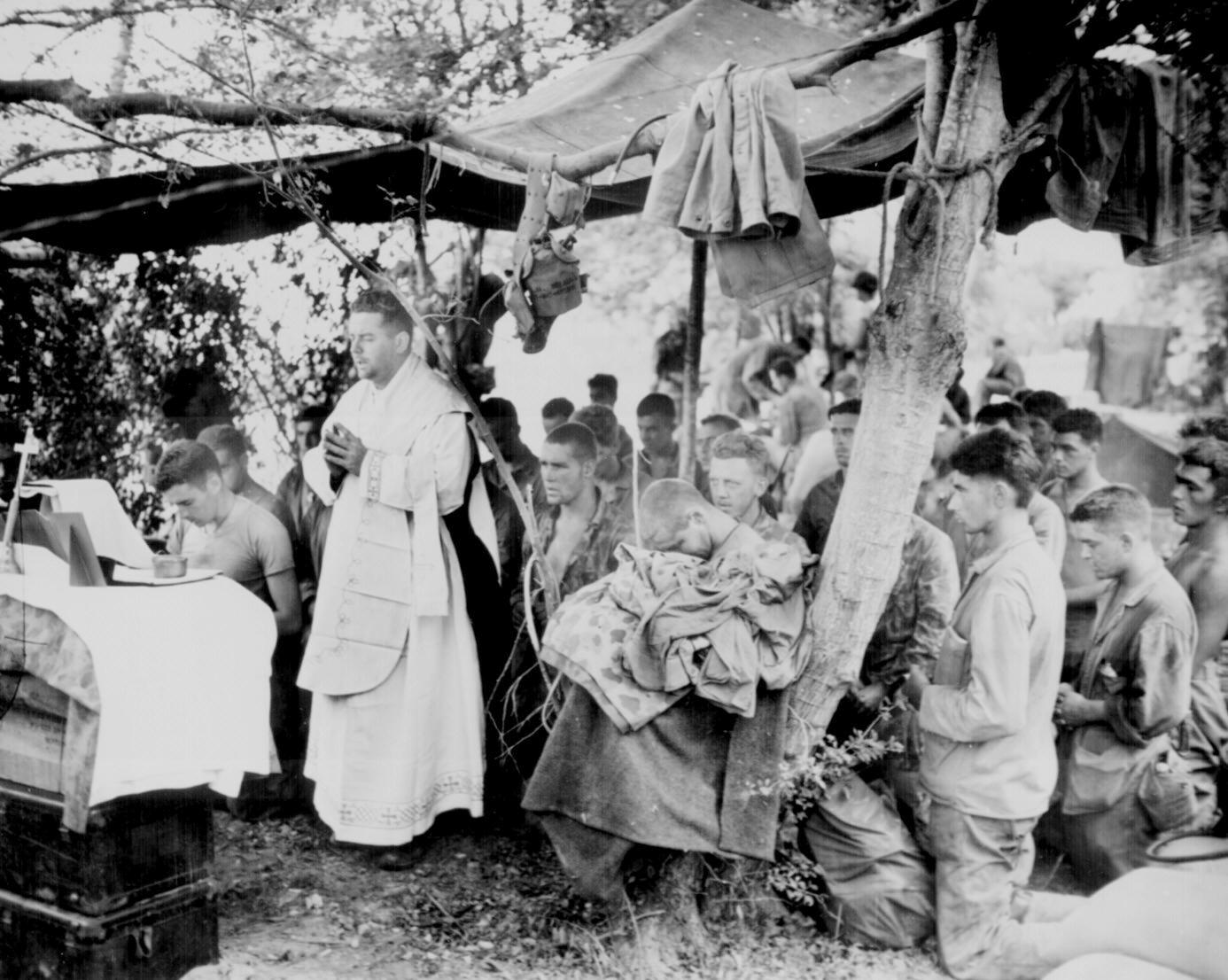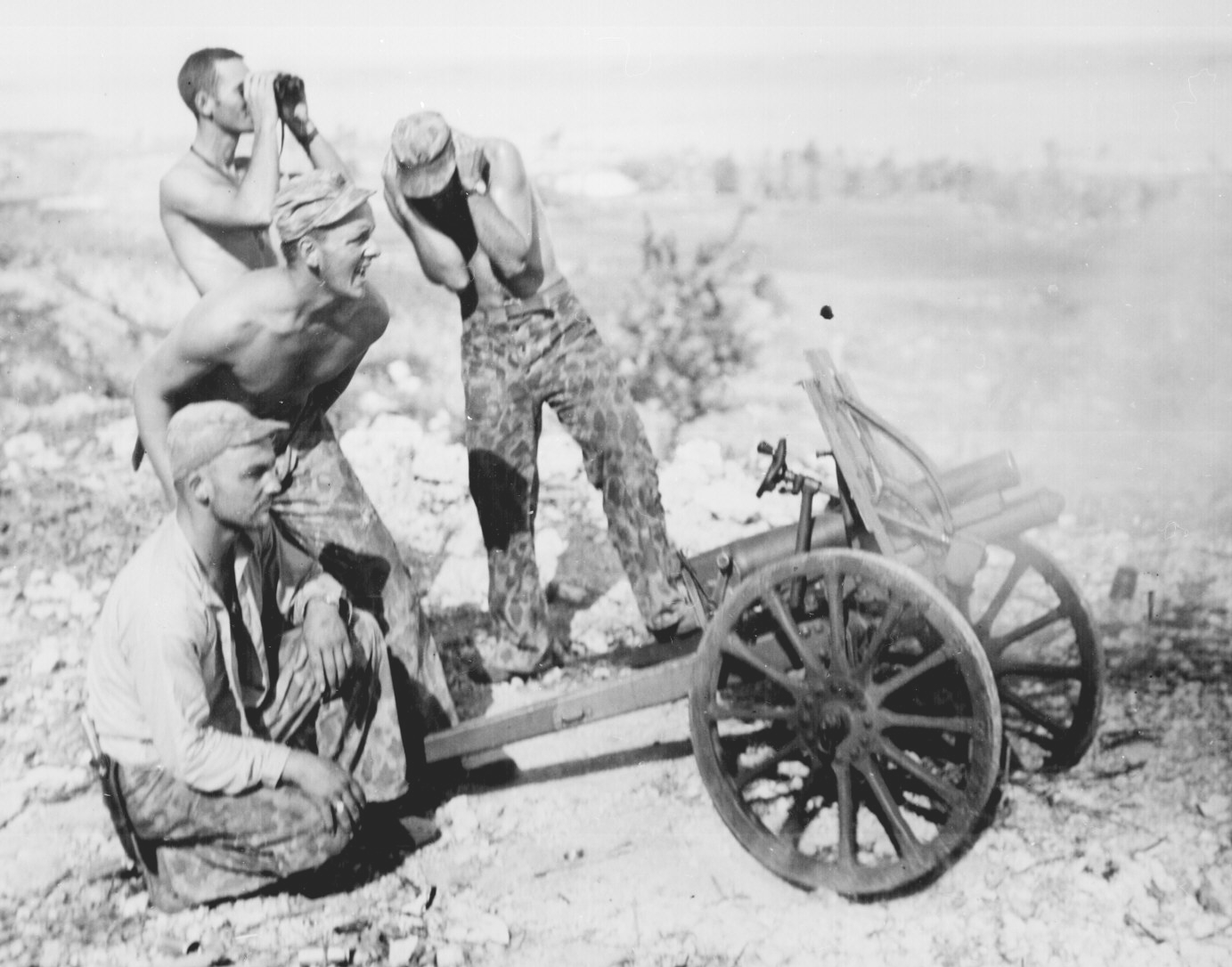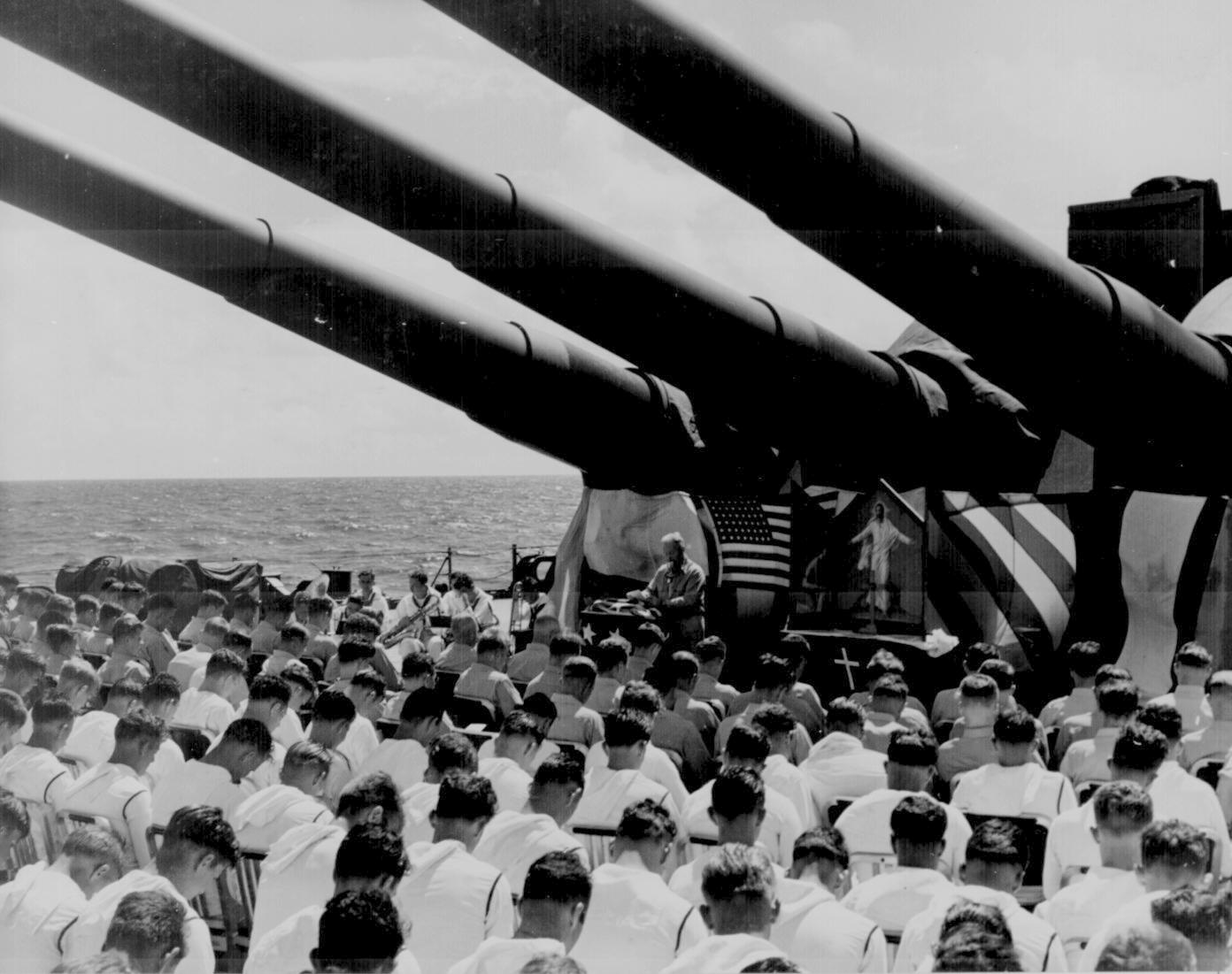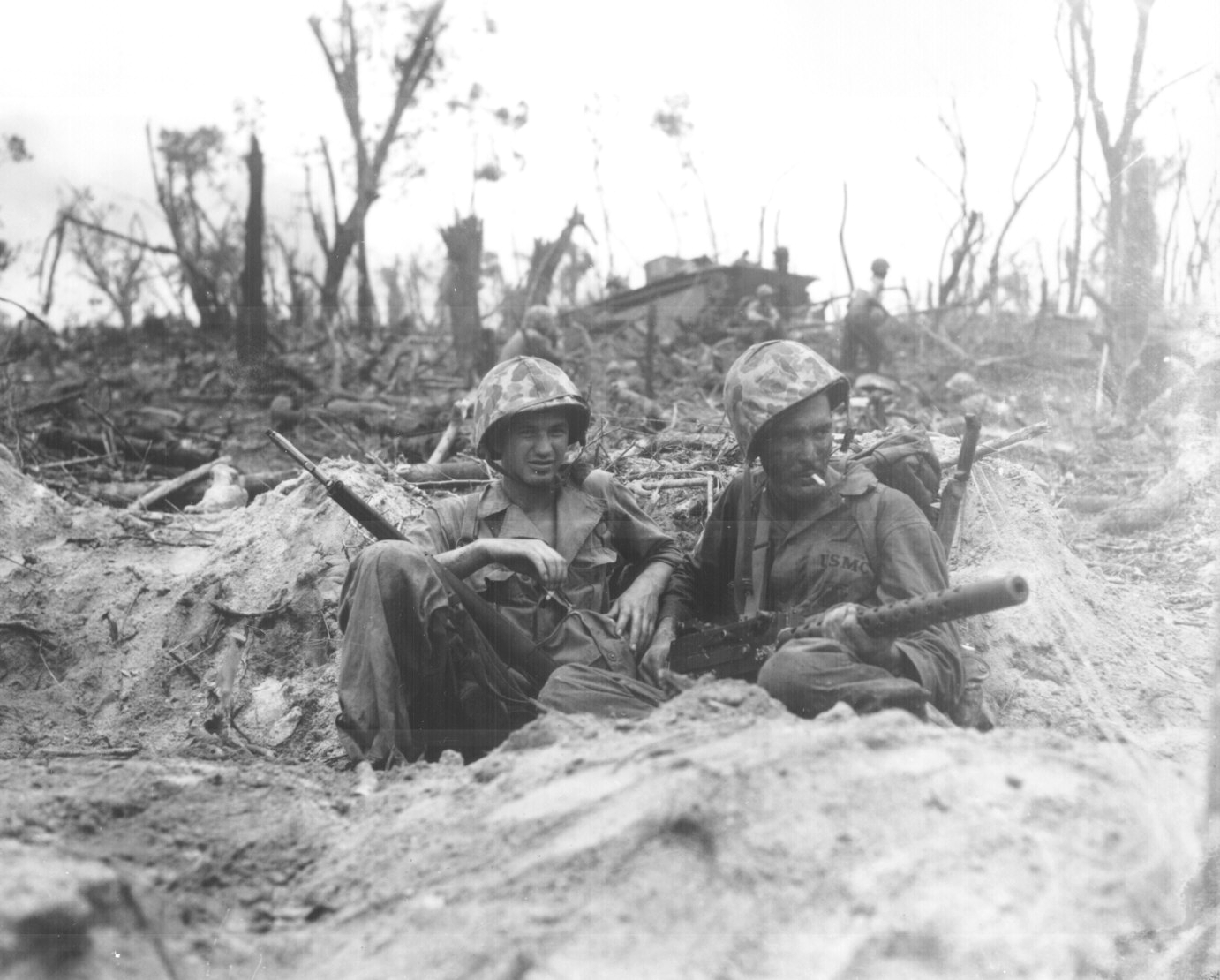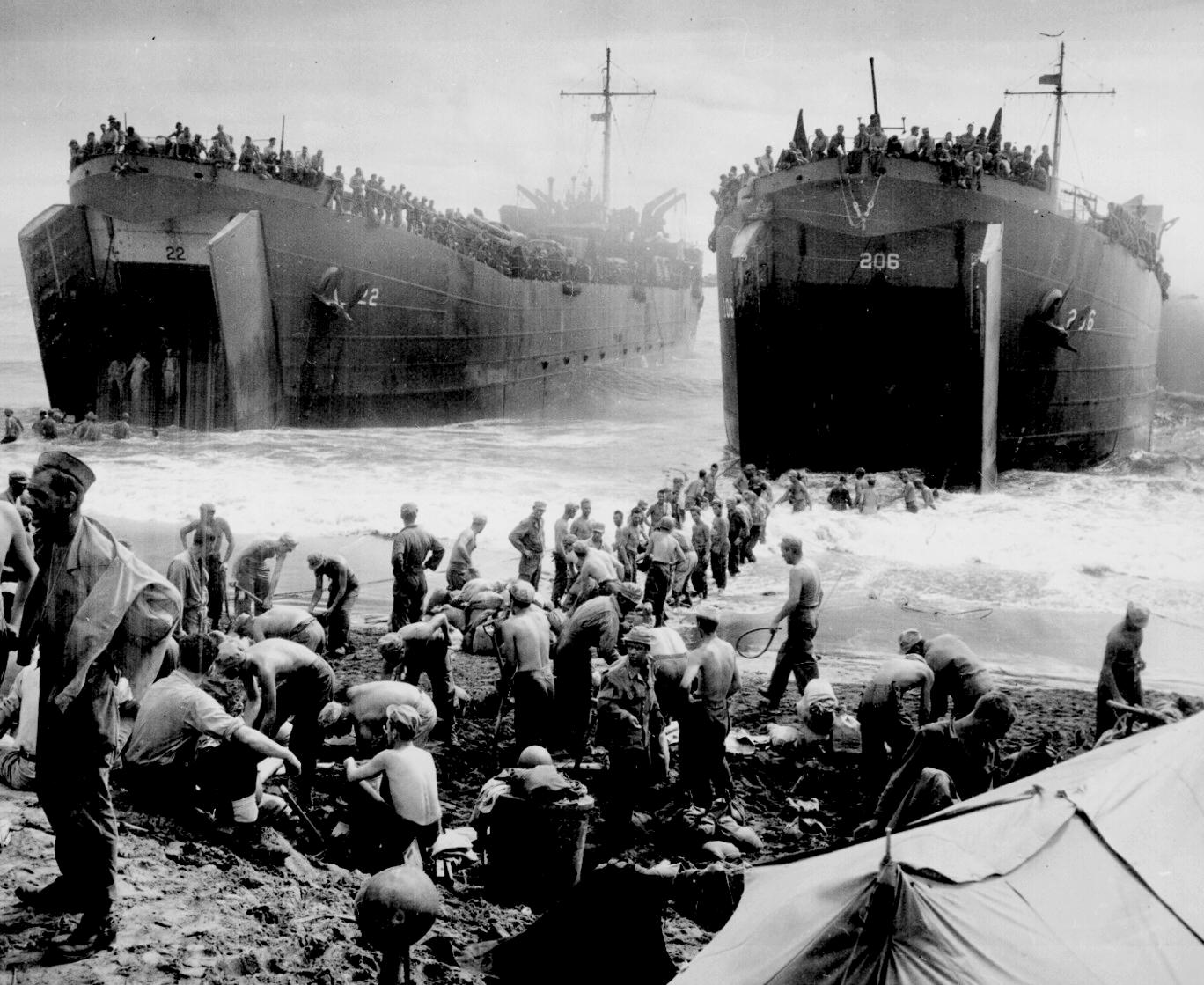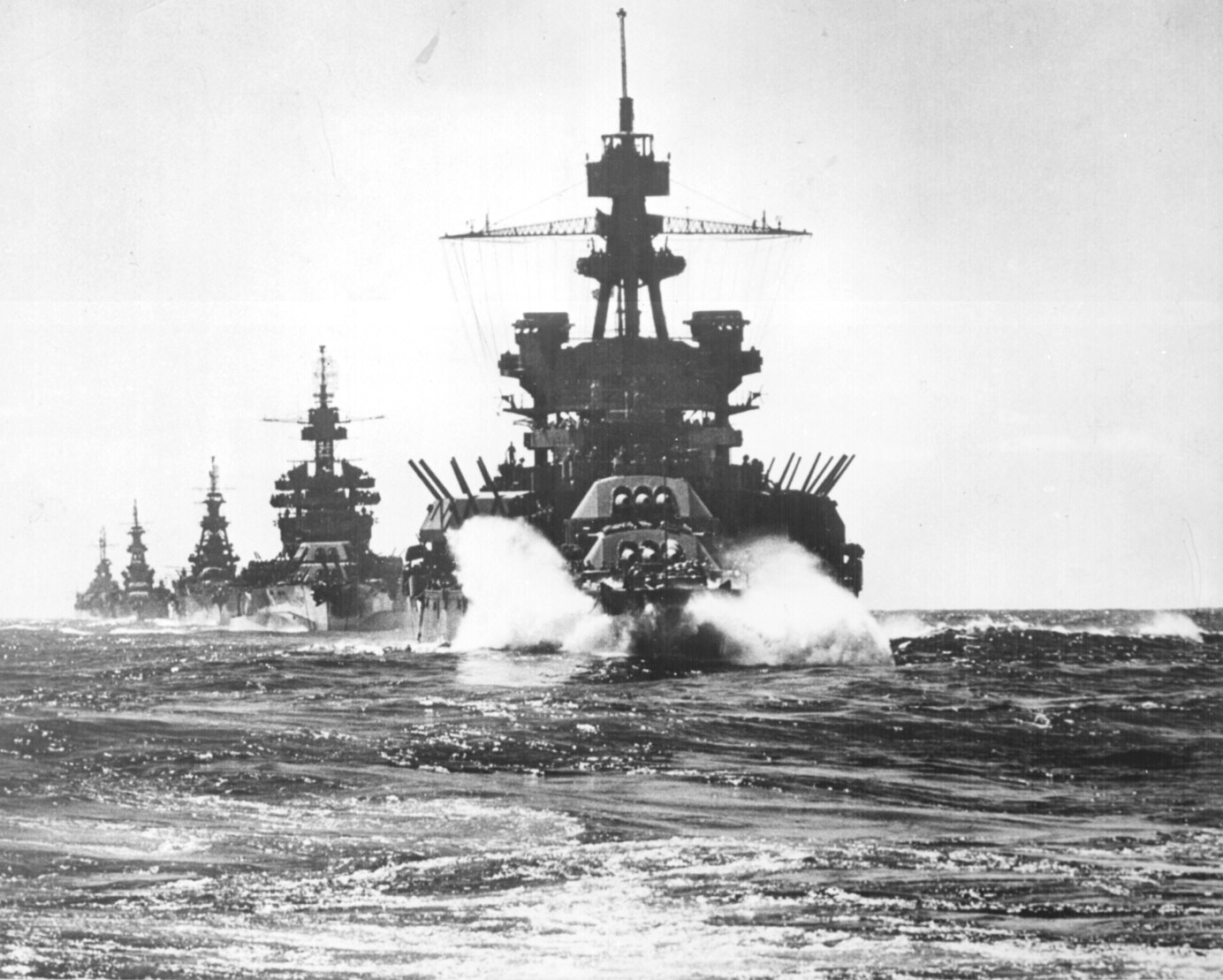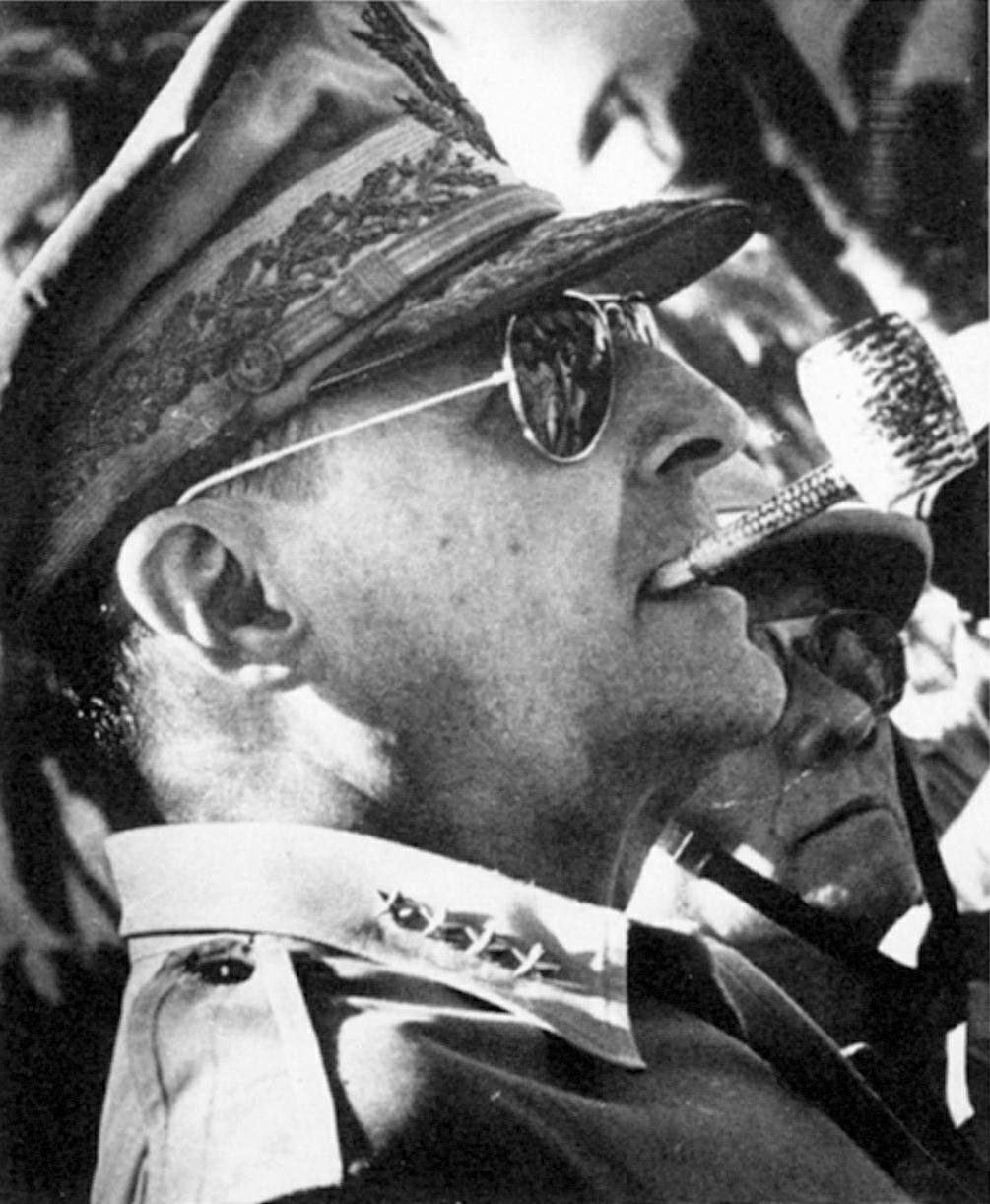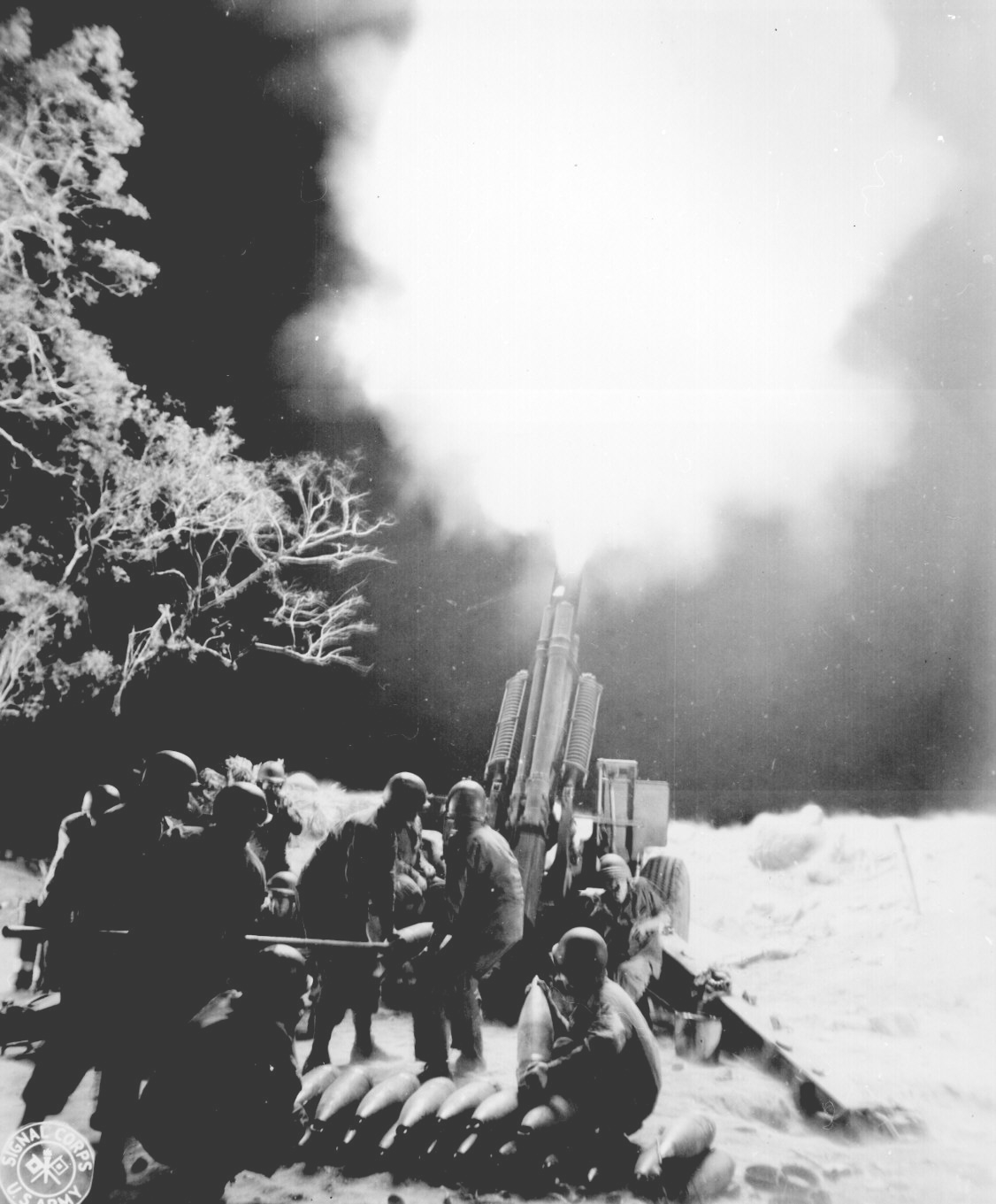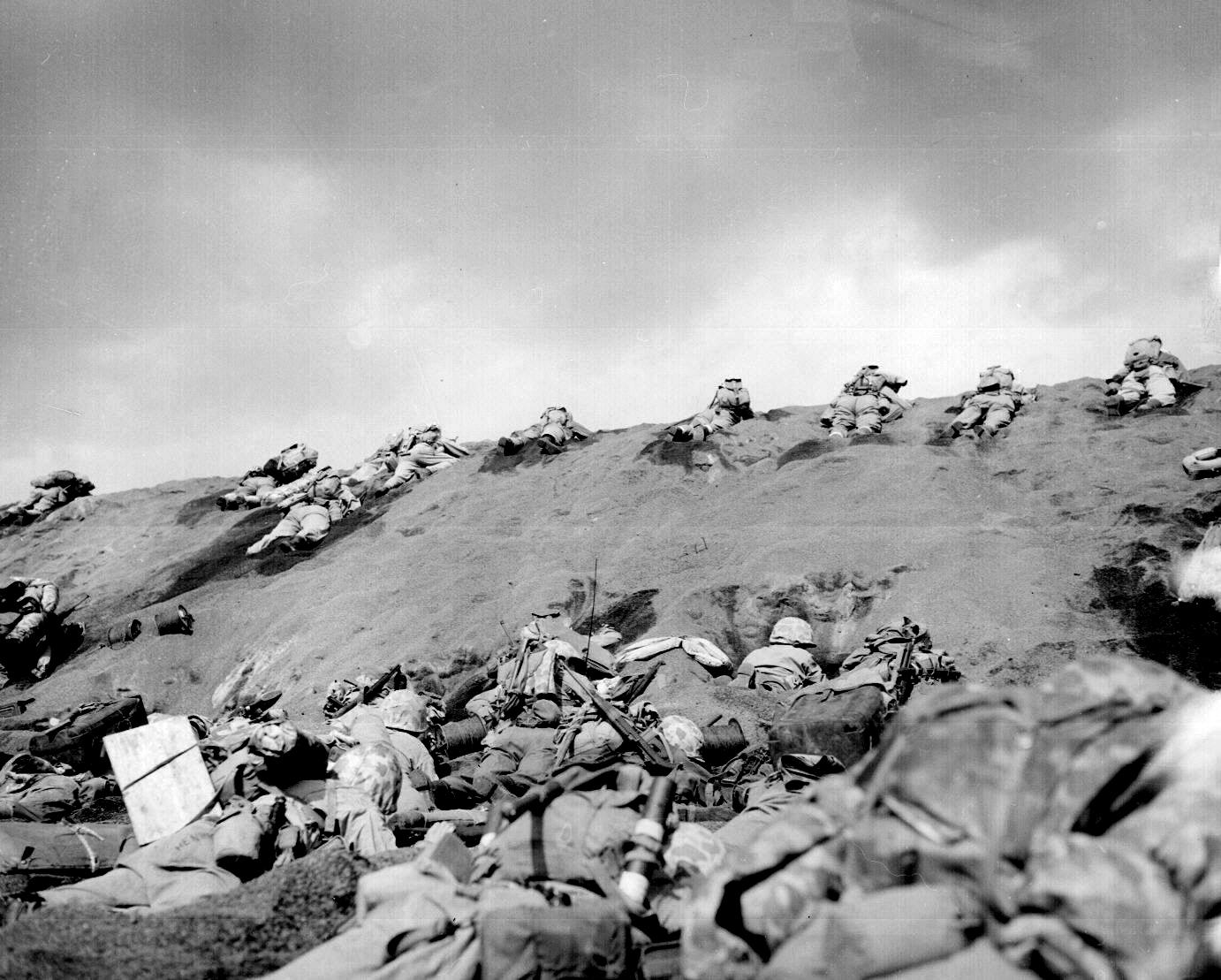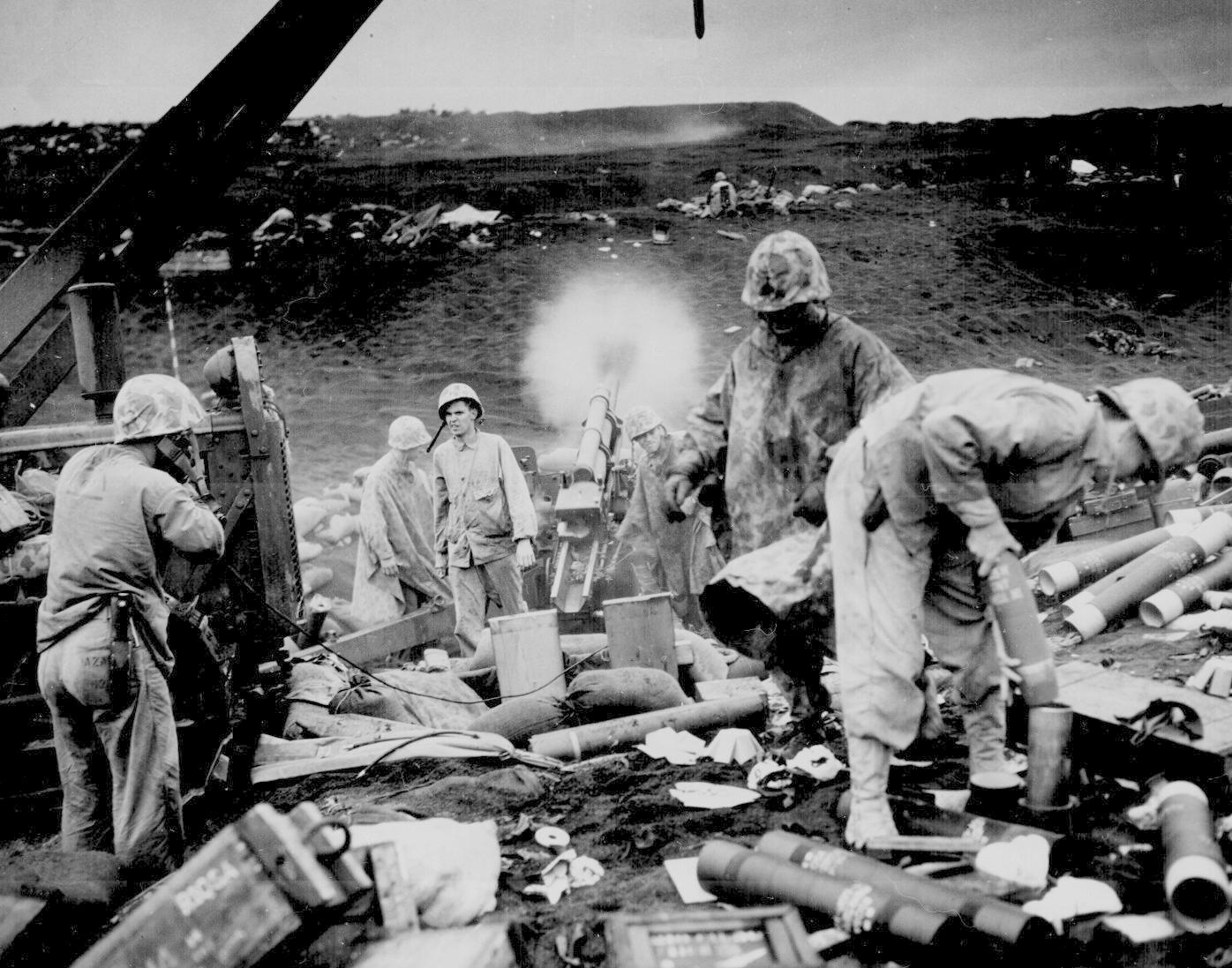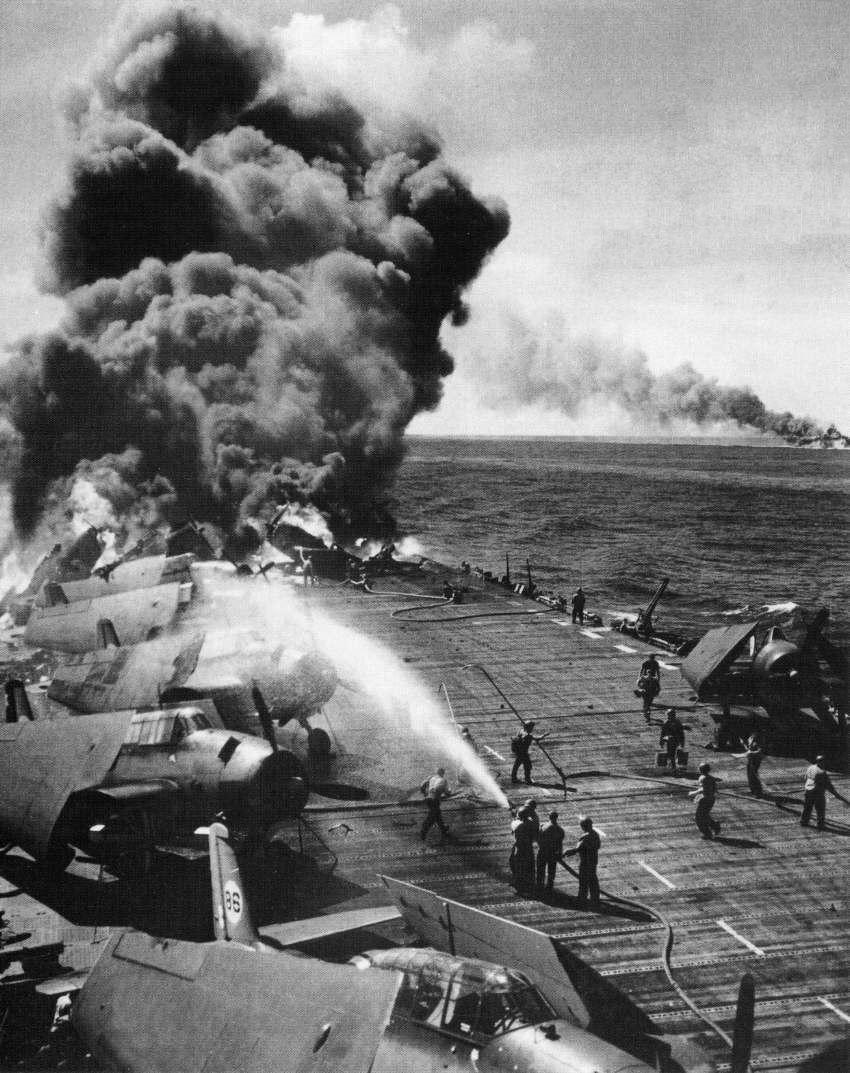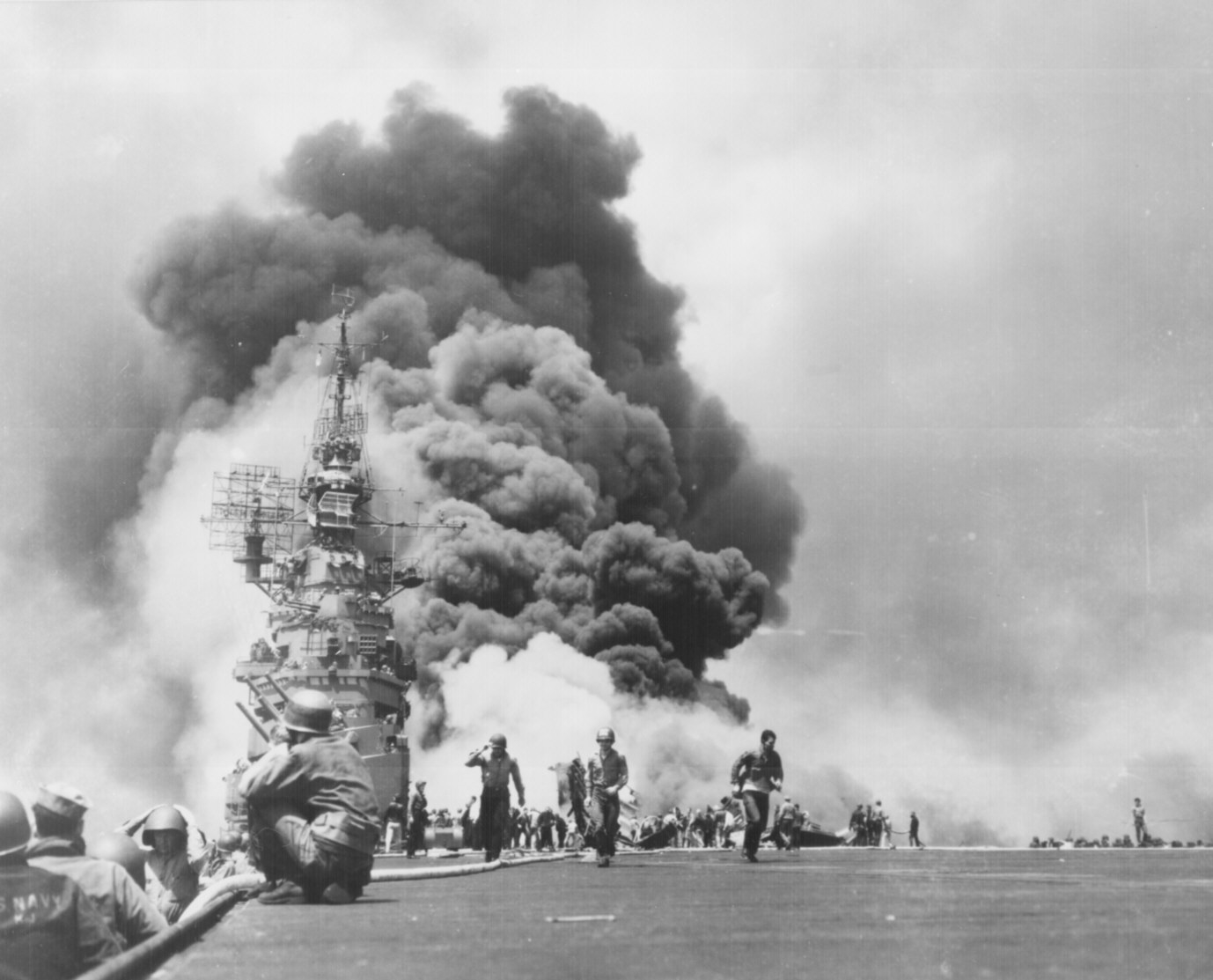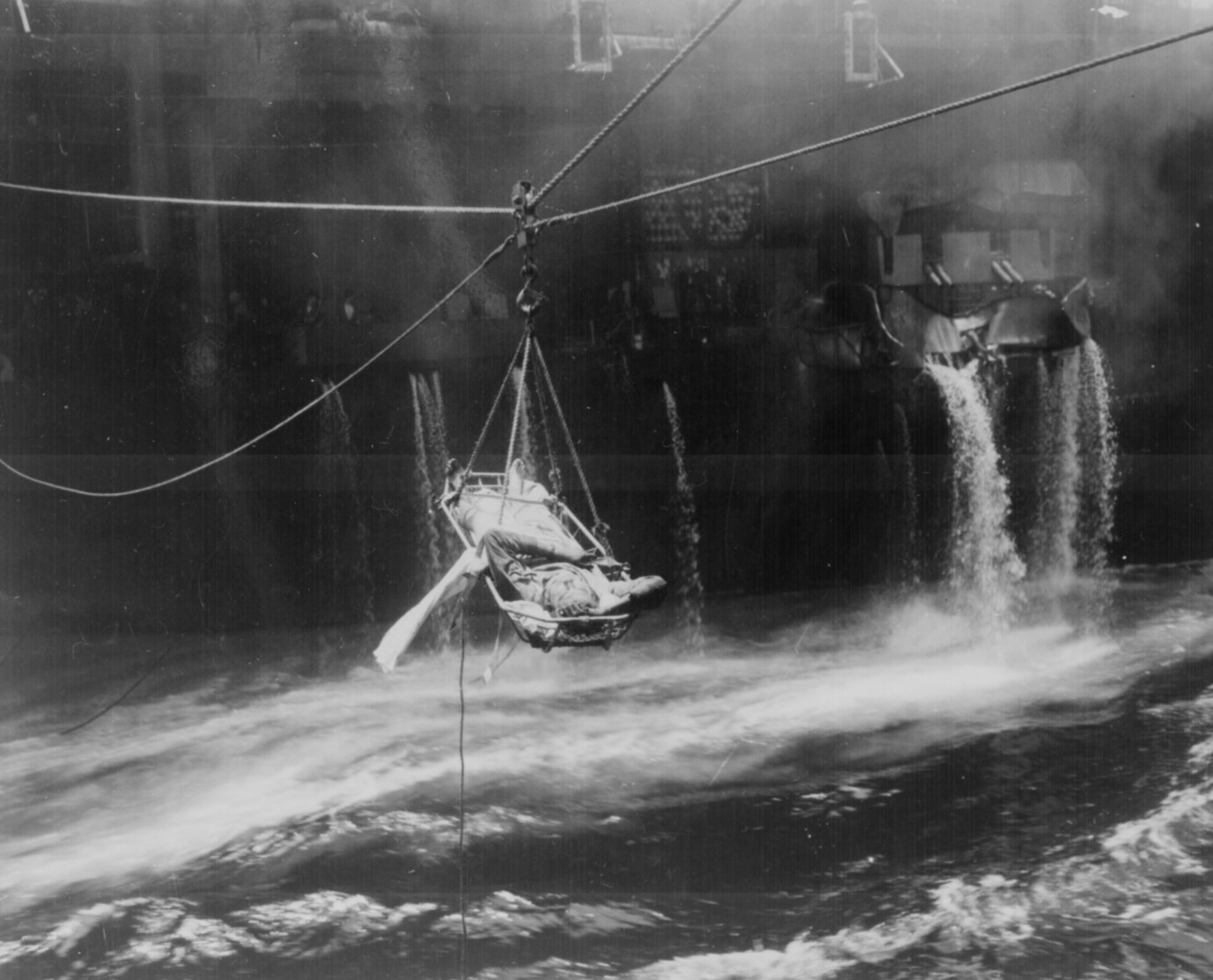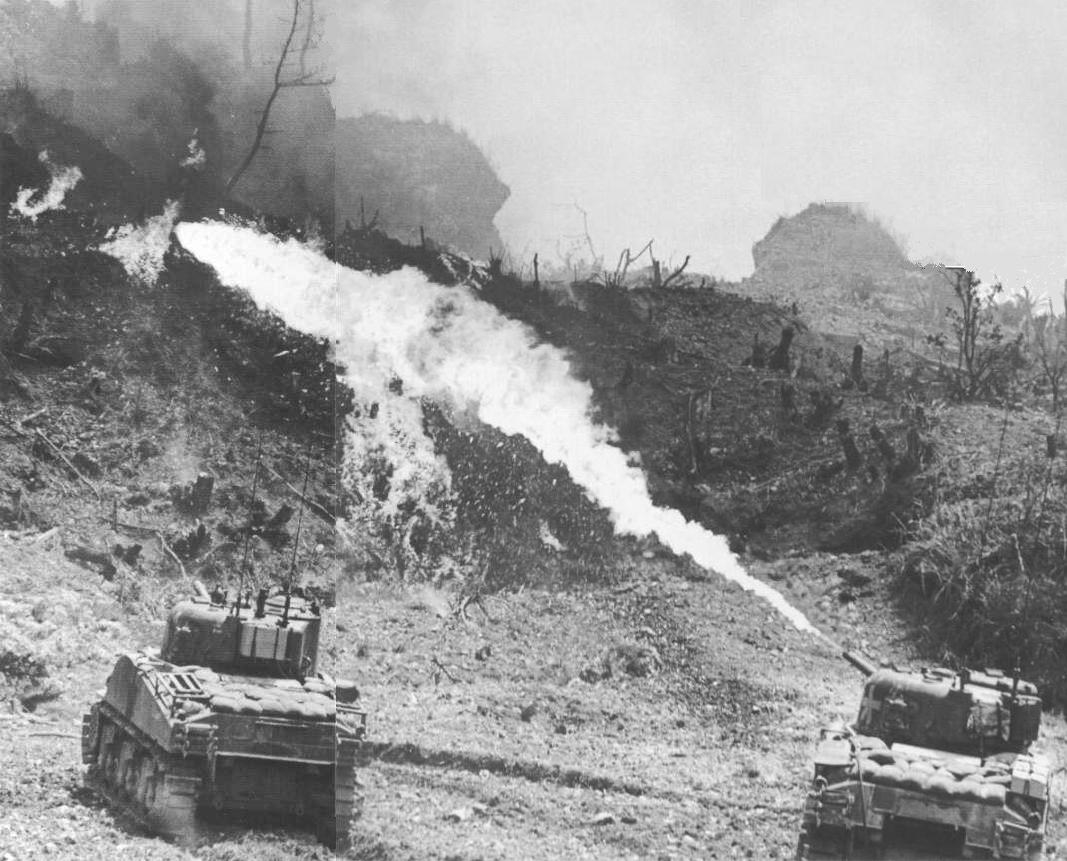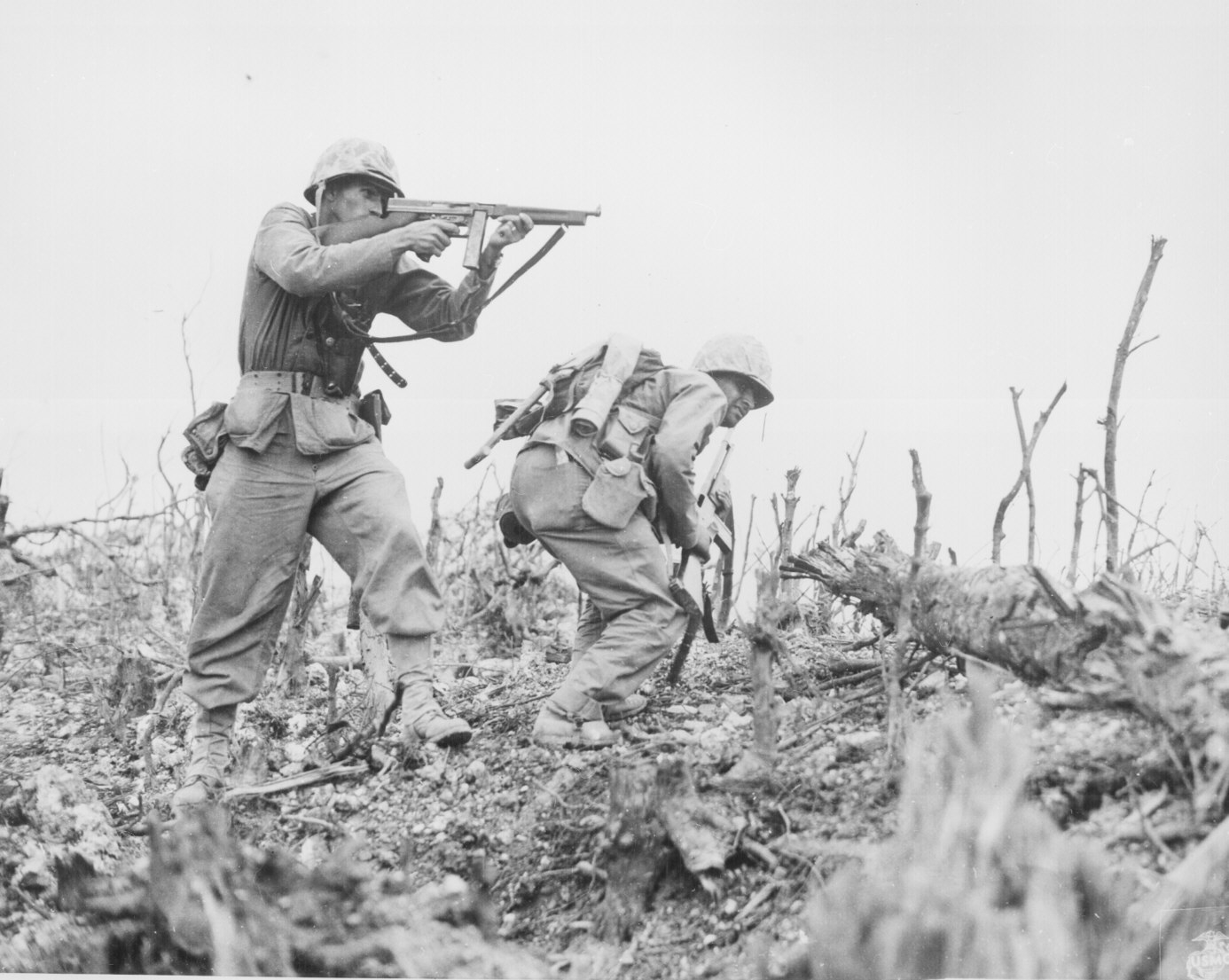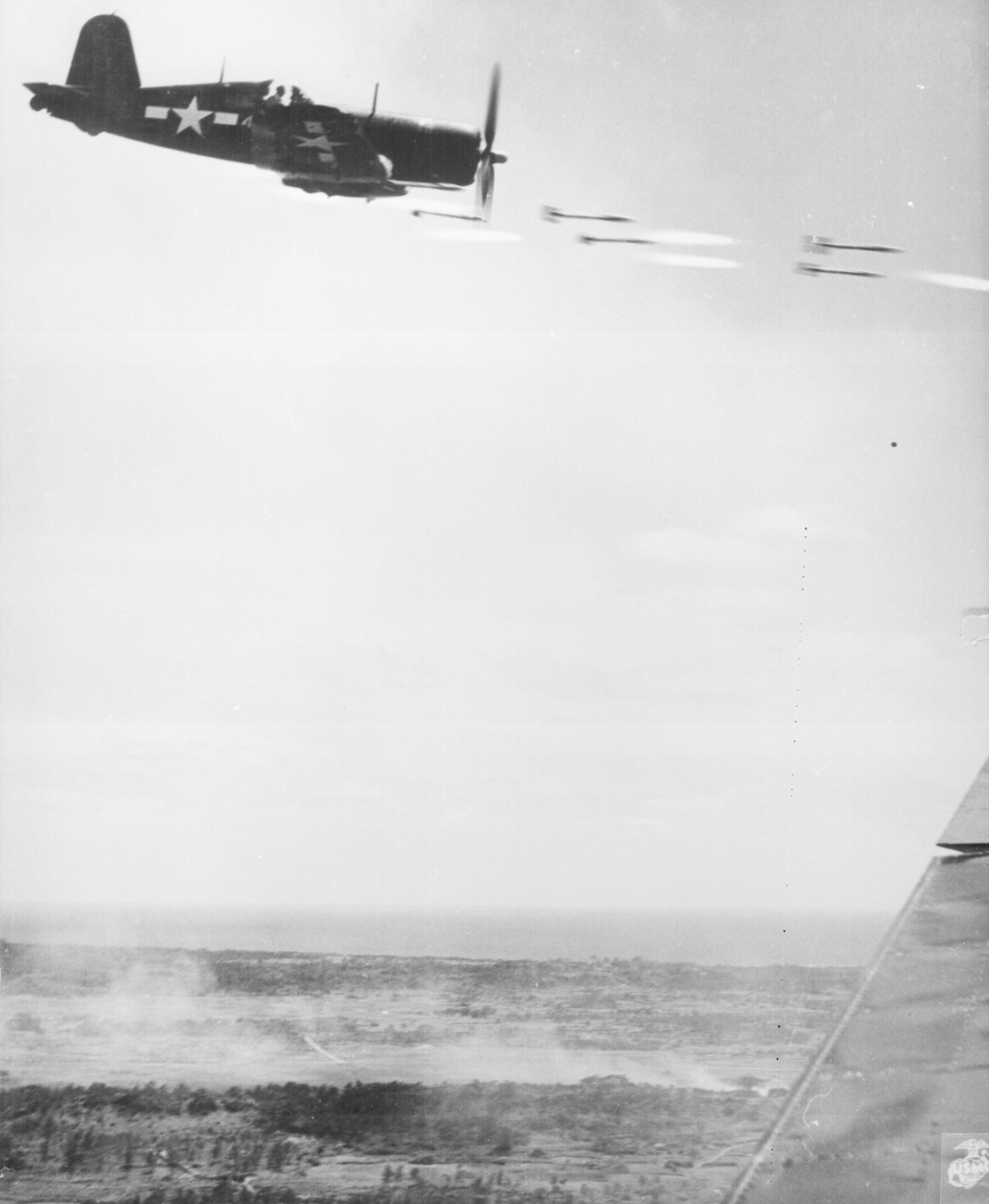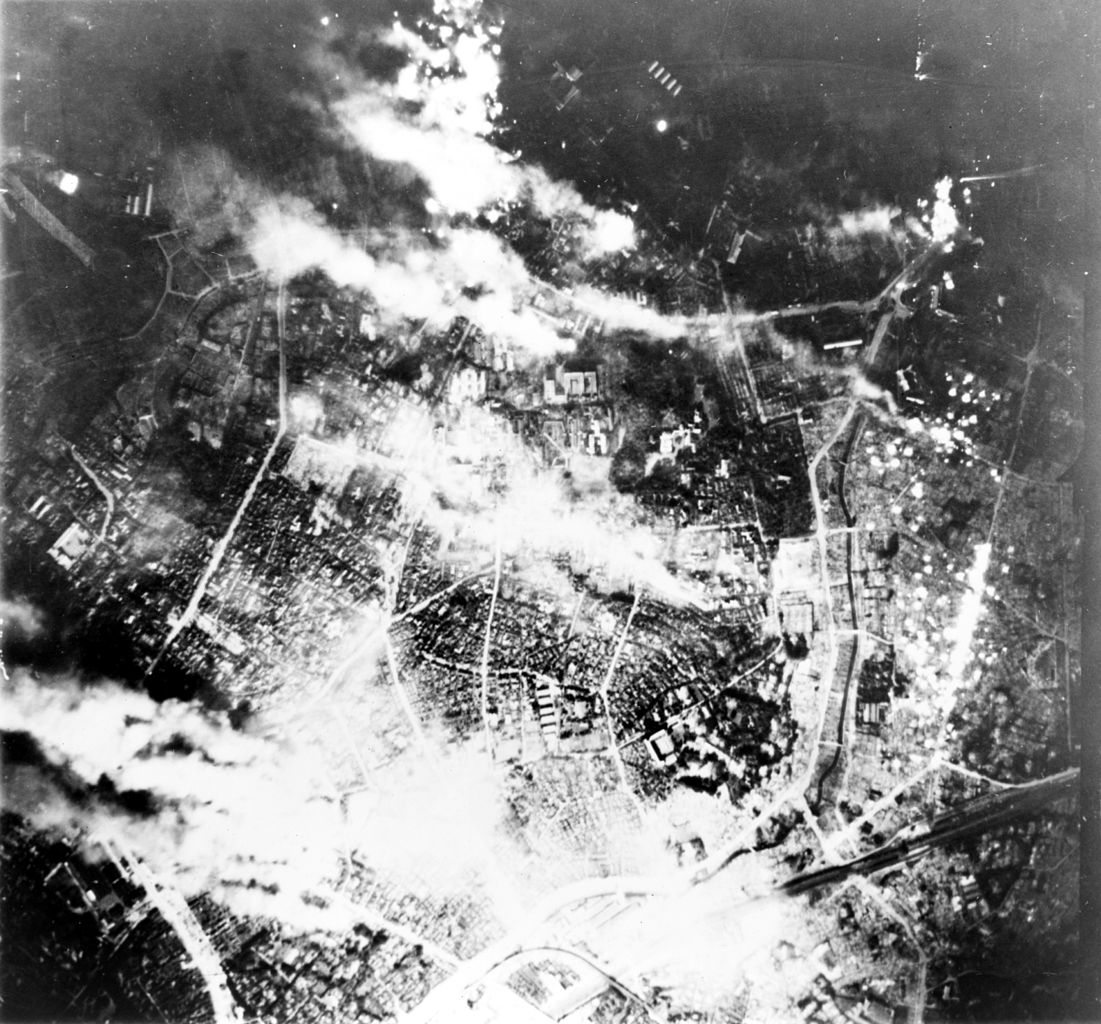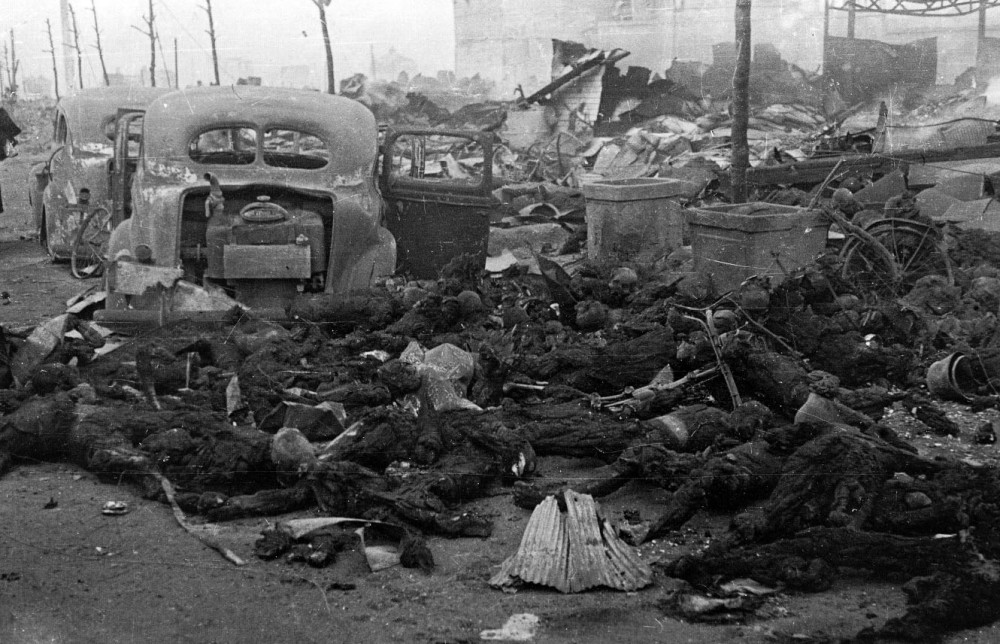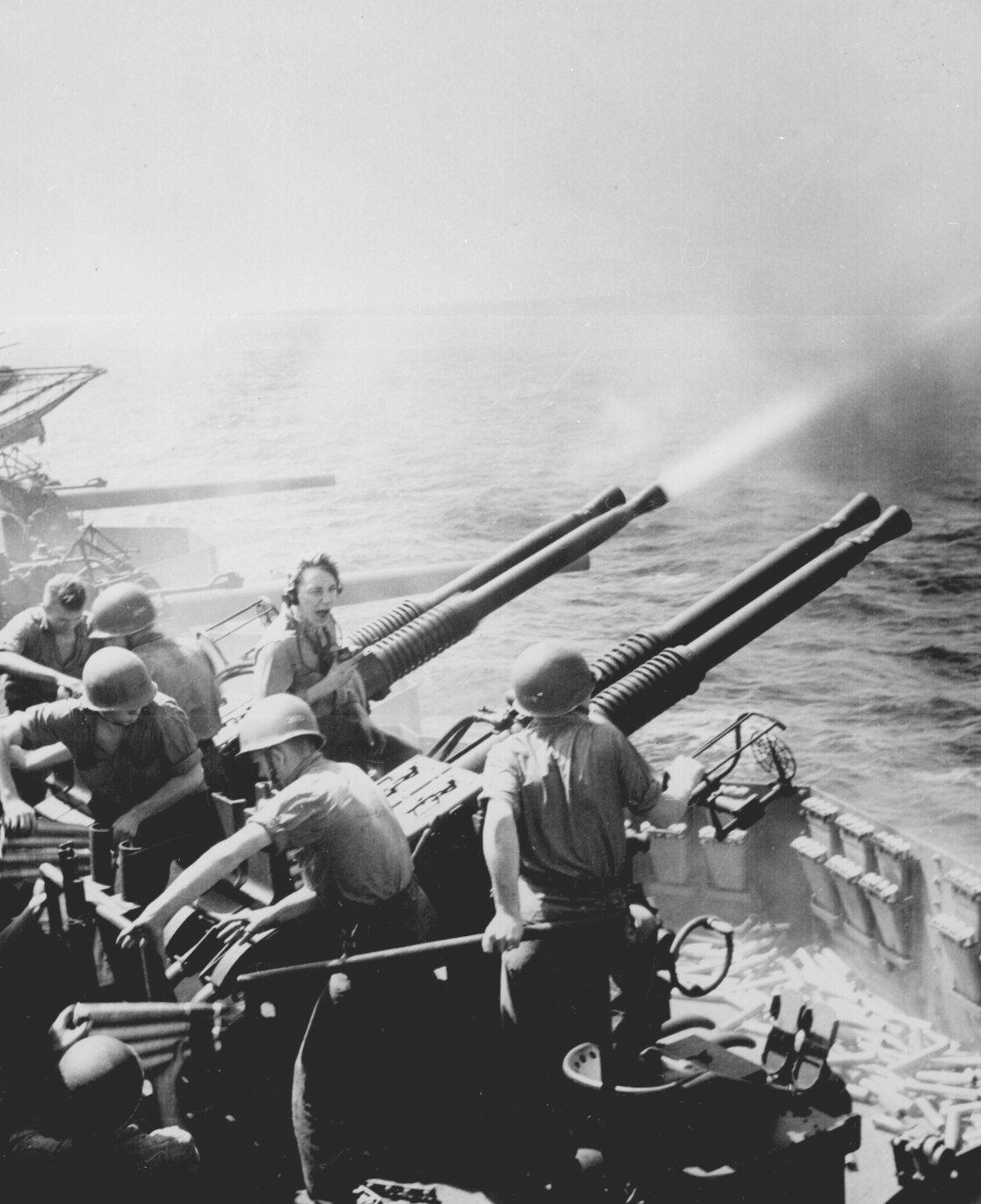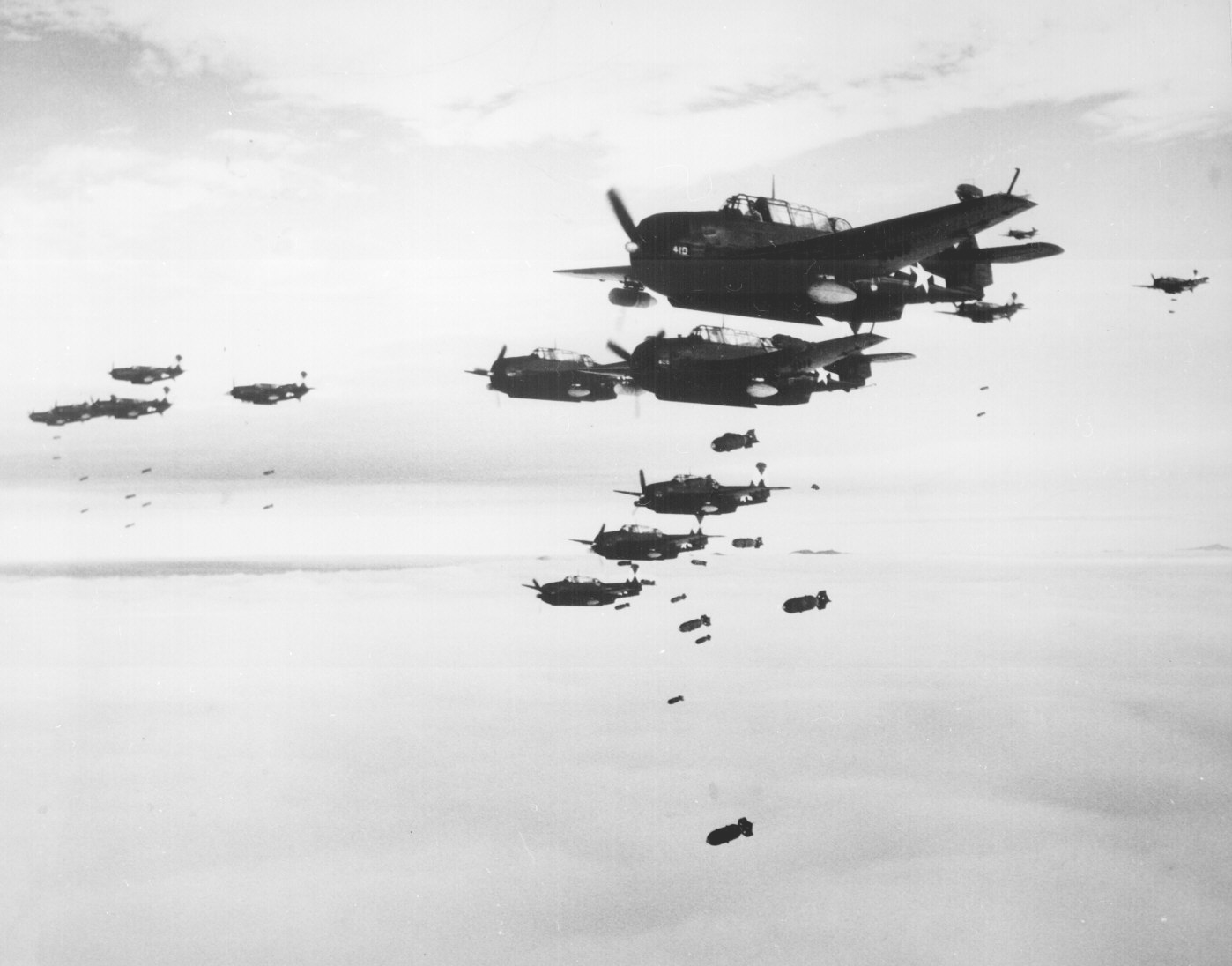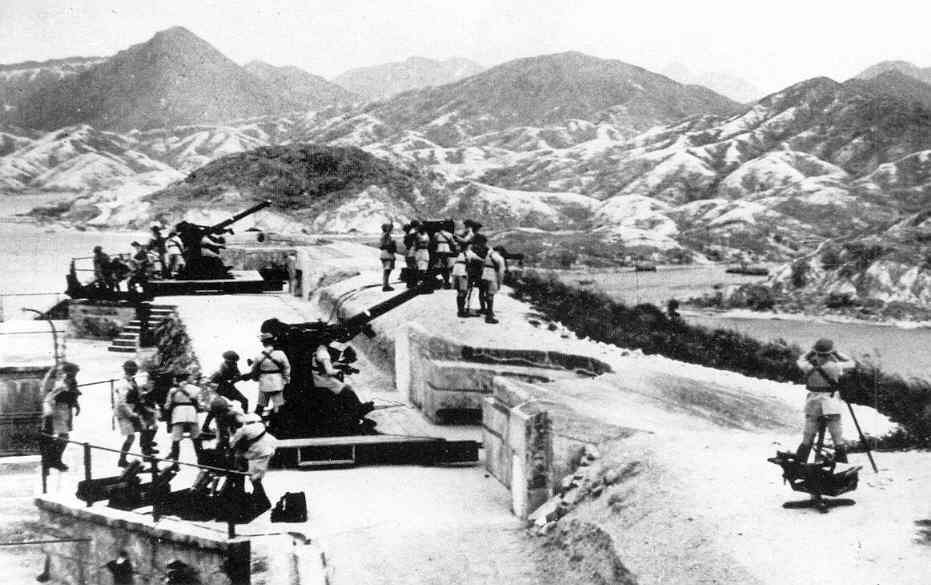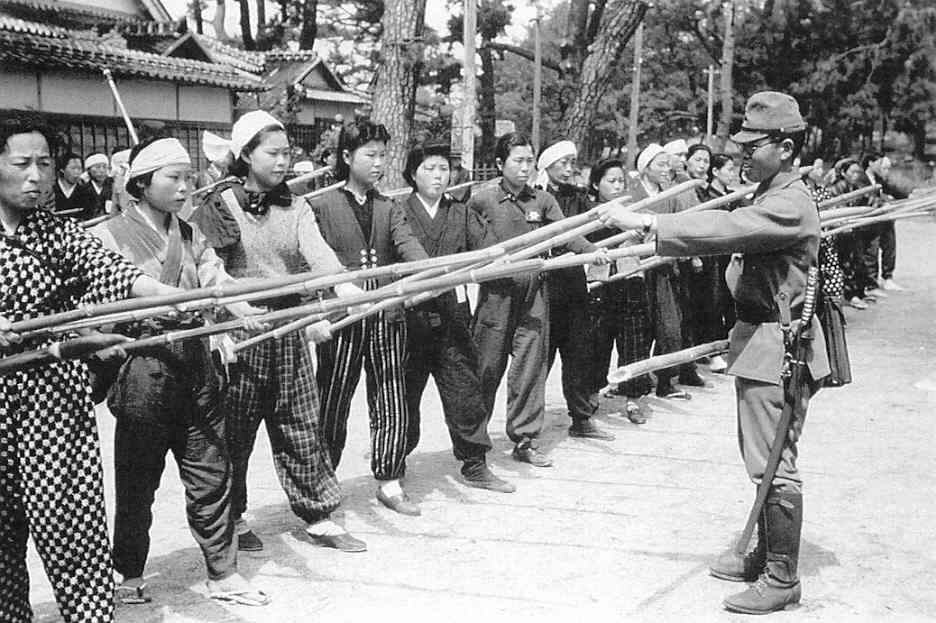16. WORLD WAR – ROUND TWO


THE FULL ASSAULT ON JAPAN
 Island hopping (in from the East)
Island hopping (in from the East)
 Meanwhile, the Allied advance up from
Meanwhile, the Allied advance up from
the South
The textual material on page below is drawn directly from my work
A Moral History of Western Society © 2024, Volume Two, pages 188-190.
ISLAND HOPPING (IN FROM THE EAST) |
| The
general strategy of the Allies (largely American in this particular
theater) against the Japanese in occupation of the numerous Pacific
islands was not to take each island held by the Japanese one by one,
but simply select a few islands that were strategically located in the
group, and which offered excellent staging ground (by sea and by air)
for their advance deeper into Japanese territory. As the Allies
largely held control of the sea and air, Rabaul and the Pacific islands
the Allies by-passed would find themselves cut off from Japanese
resupply ... and thus could be brought under full Allied control at a
later date. But the islands they did pick to undertake landings were always the scenes of considerable Japanese resistance, especially as the Japanese tended to dig in deeply ... hoping to create impenetrable lines of defense against the advancing Allies. But the Allies bombed and torched (napalm) these defenses as they went. The death toll was tremendously high, especially on the Japanese side. But Allied losses were also very high. With American Admiral Chester W. Nimitz in command, the objective was to secure islands close enough to Japan that the mainland, especially the industrial cities of coastal Japan (including the capital Tokyo), could be hit by long range American bombers. Thus it was that Tarawa (November 1943), in the Gilbert Islands well south of this line of advance, was the first target of this effort. This was followed up by the taking of the islands of Kwajalein and Eniwetok (February 1944). From there the Americans took the islands of Saipan (June-July), Tinian (July) and – most importantly – Guam (July-August). From this point on, the Japanese civilians found themselves as familiar as the Germans as to what it felt like to have the horrors of war inflicted on them and their homes and cities … rather than just on their enemies. The Allied bombing of Japan would now be relentless. |
Saipan (15 June to 9 July, 1944)
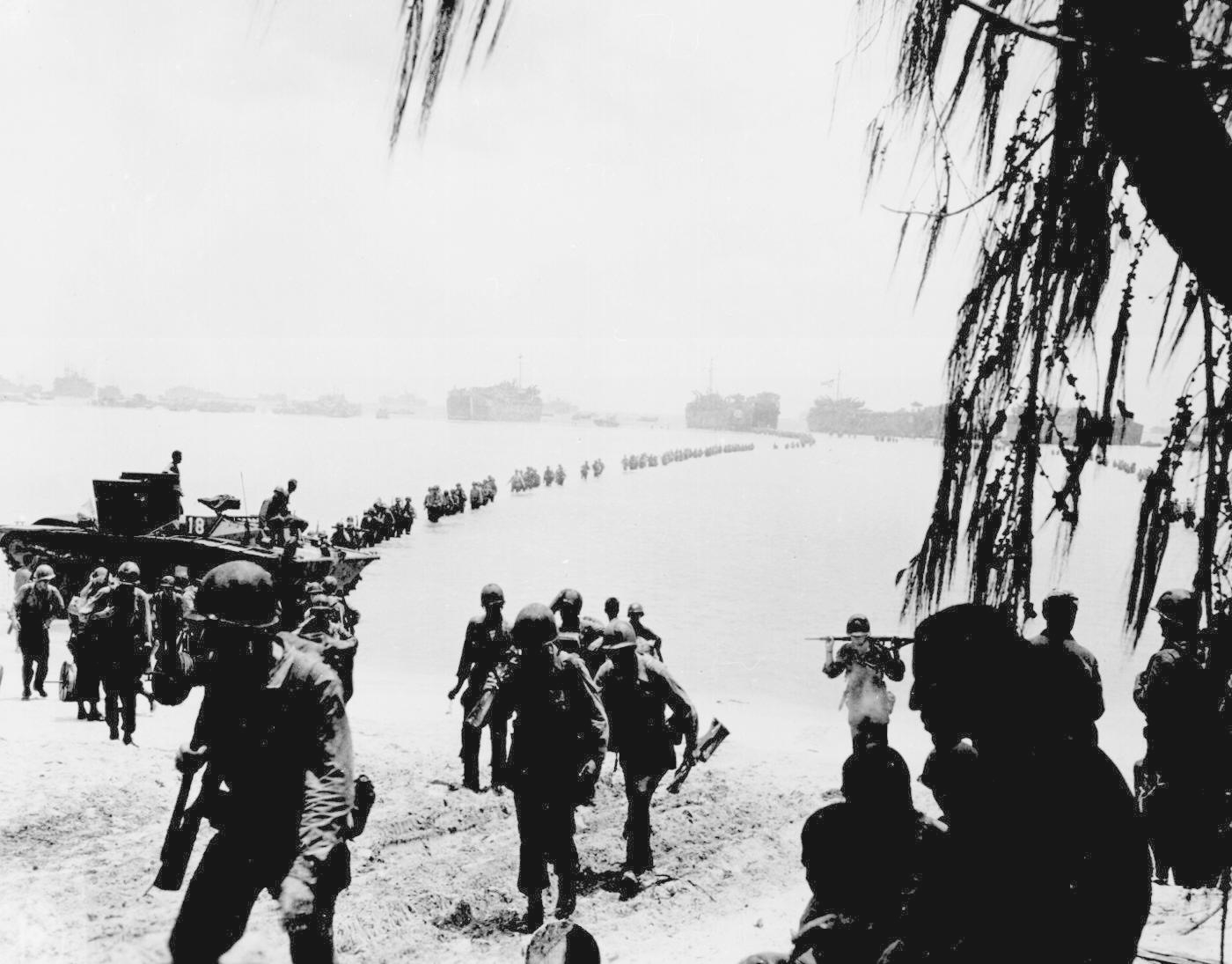

"With a canvas tarpaulin for a church and packing cases for an altar, a Navy chaplain holds mass for Marines at Saipan. The service was held in memory of brave buddies who lost their lives in the initial landings." Sgt. Steele, June 1944.
"After the Marines captured this mountain gun from the Japs at Saipan, they put it into useduring the attack on Garapan, administrative center of the island." Cpl. Angus Robertson, ca. July 1944.
"First flag on Guam on boat hook mast.
Two U.S. officers plant the American flag on Guam eight minutes after U.S. Marines
and
Army assault troops landed on the Central Pacific island on July
20, 1944."
"The crew of the USS South Dakota stands with bowed heads, while Chaplain N. D. Lindner reads the benediction held in honor of fellow shipmates killed in the air action off Guam on June 19, 1944." July 1, 1944.
"Marine Pfc. Douglas Lightheart (right) cradles his 30-cal. machine gun in his lap, while he and his buddy Pfc. Gerald Churchby take time out for a cigarette, while mopping up the enemy on Peleliu Is." Cpl. H. H. Clements, September 14, 1944
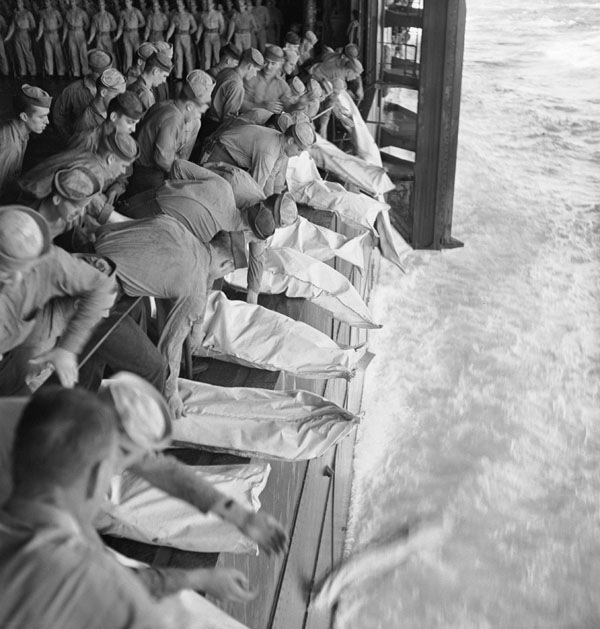
"Burial at sea for the officers and men of the USS Intrepid (CV-11) who lost their lives when the carrier was hit by Japanese bombs during operations in the Philippines." Lt. Barrett Gallagher, November 26, 1944
MEANWHILE, THE ALLIED ADVANCE UP FROM THE SOUTH |
| A
second command, coming up from just offshore from Dutch New Guinea ,
had as its object the retaking of the Philippines from the
Japanese. For its commanding General Douglas MacArthur, the
Philippines constituted something he held as a personal objective, for
in leaving the Philippines in 1942, he had guaranteed the Filipinos: "I
shall return." The startup – from the huge island of Dutch New Guinea (just north of Australia) and to the east from the Solomon Islands (north of Guadalcanal) – was slow and also very bloody … Bougainville being chief among these islands and taking from November 1943 to February of 1944 to secure. In October of 1944, the Allies reached the Philippine island of Leyte ... but found the Japanese navy waiting for them. A huge sea battle resulted ... which the Japanese lost decisively. But even then, it would not be until December that Leyte was fully in Allied hands. With much fanfare General MacArthur came ashore at Leyte Island, cameras recording the event with a properly dramatic effect. He had finally fulfilled his promise. But the full liberation of the Philippines was yet ahead. From Leyte the Americans swung around the Philippines’ main island of Luzon to land on its northern shore (January 1945) ... and then to advance south across the island toward the Philippine capital of Manila. In Manila itself, fierce house to house fighting followed until finally in late February the capital was cleared of the last of the Japanese troops ... with much horrifying destruction brought to the city and its people. And once again, the Japanese casualties were also enormously high, the Japanese resolved to fight to the last man standing rather than to surrender. |
Liberating the Philippines - beginning with Leyte - and then advancing to Luzon

"The gun crews of a Navy cruiser covering
American landing on the island of Mindoro, Dec. 15, 1944, scan the skies in an
effort to identify a plane overhead. Two 5" (127mm) guns are ready while
inboard 20mm anti-aircraft crews are ready to act."
National Archives
80-G-47471.
"Two Coast Guard-manned LST's open their
great jaws in the surf that washes on Leyte Island beach, as soldiers strip
down and build sandbag piers out to the ramps to speed up unloading
operations." 1944.
National Archives
"USS PENNSYLVANIA and battleship of
COLORADO class followed by three cruisers >move in line into Lingayen Gulf preceding
the landing on Luzon." Philippines, January 1945.
National Archives
80-G-59525
"A line of Coast Guard landing barges,
sweeping through the waters of Lingayen Gulf, carries the first wave of invaders to the beaches of
Luzon, after a terrific naval bombardment of Jap shore positions
on Jan.
9, 1945." PhoM1c. Ted Needham.
National Archives 26-G-3856.

National Archives

"General MacArthur surveys
the beachhead on Leyte Island, soon after American forces swept ashore
from a gigantic liberation armada into the central Philippines, at the historic moment when
the General made good his promise 'I shall return.'" 1944.
National Archives
"Veteran Artillery men of the `C' Battery,
90th Field Artillery, lay down a murderous barrage on
troublesome Jap artillery
positions in Balete Pass, Luzon, P.I." Morton, April 19, 1945.
National Archives
111-SC-205918.
"Pilots aboard a U.S. Navy aircraft
carrier receive last minute instructions before taking off to attack industrial, and military
installations in Tokyo." February 17, 1945.
National Archives
208-N-38374
CLOSING IN ON JAPAN |
| Iwo Jima (February 1945).
In mid-February, American Marines went ashore on the Island of Iwo
Jima, the first truly Japanese island comprising the Japanese island
group. Here Americans would discover what they could expect by
way of Japanese resistance now that they were actually on Japanese
soil. It would take almost six weeks to break the last of the Japanese
resistance on the island. Approximately 90 per cent of the
Japanese force of 20,000 was killed (or committed suicide) in the
action. Okinawa (April 1945). At the beginning of April, a huge armada of 1400 American ships sent troops ashore on the Japanese island of Okinawa. This large island was so strongly defended in the south that it took three months of battle to finally bring it under Allied control (the Japanese killed in action numbered fourteen times the Allies killed, a clear indicator of the Japanese resolve to fight). Air and sea attacks on Japanese territory itself. By this point, the Americans were finding themselves closer to the Japanese heartland – and the Japanese air force offering little defense against the bombing runs of the Americans on their cities. Tokyo was being hit by intense fire-bombing which was turning the Japanese capital into a fiery inferno. Yet the Japanese showed no sign of weakening in their resistance to the advancing Americans. Kamikaze. What air action that the Japanese did offer (at Okinawa) was suicidal ... a desperate effort of 4,000 young (and inexperienced) Japanese kamikaze ("divine wind") pilots to hurl themselves and their explosives laden planes at the American ships advancing on their islands. Only a small percentage were able to hit a ship. Nonetheless, the effort certainly unnerved the American sailors – with 30 ships sunk and over 300 others badly damaged by the fanatical kamikaze pilots. Nonetheless, the Japanese naval attack on the American fleet failed to stop the American advance. By now it was clear that the Americans were unstoppable. But it was also clear that the Japanese did not seem willing to give up the fight as long as there were any Japanese still alive to fight. Even the women and youth were being trained in defense tactics. It looked as if the Allies were going to have to go village to village across the entirety of Japan to finally bring the war with Japan to an end. This might take years and millions of casualties to complete. |
"Marines of the 5th Division inch their
way up a slope on Red Beach No. 1 toward Surbachi Yama as the smoke of the battle drifts about
them." Dreyfuss, Iwo Jima, February 19, 1945.
National Archives
127-N-110249.
"Across the litter on Iwo Jima's black
sands, Marines of the 4th Division shell Jap positions cleverly concealed back from the beaches.
Here, a gun pumps a stream of shells into Jap positions inland on the tiny
volcanic island." ca. February 1945.
National Archives
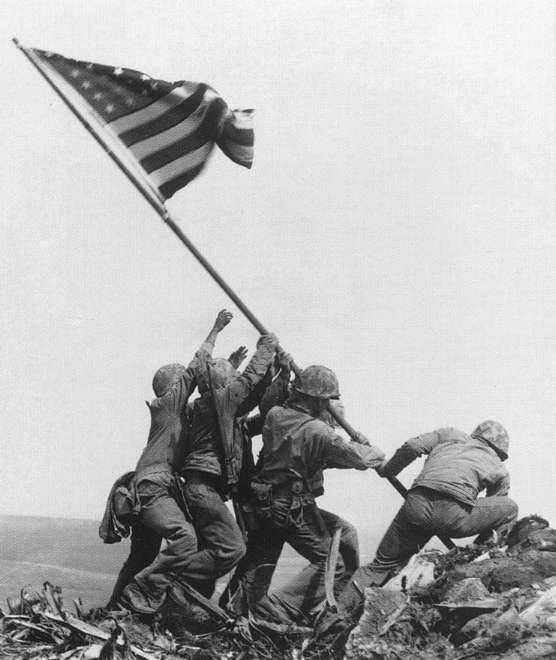
U.S. National Archives 80-G-413988
PhoM3c. Robert M. Warren, ca. February/March 1945.
National Archives 26-G-4474
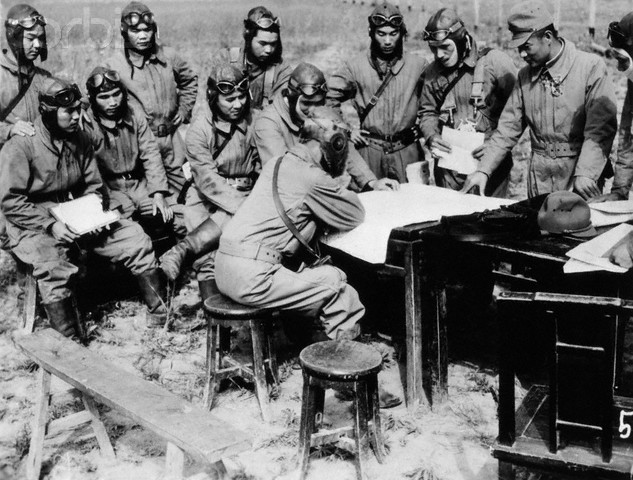
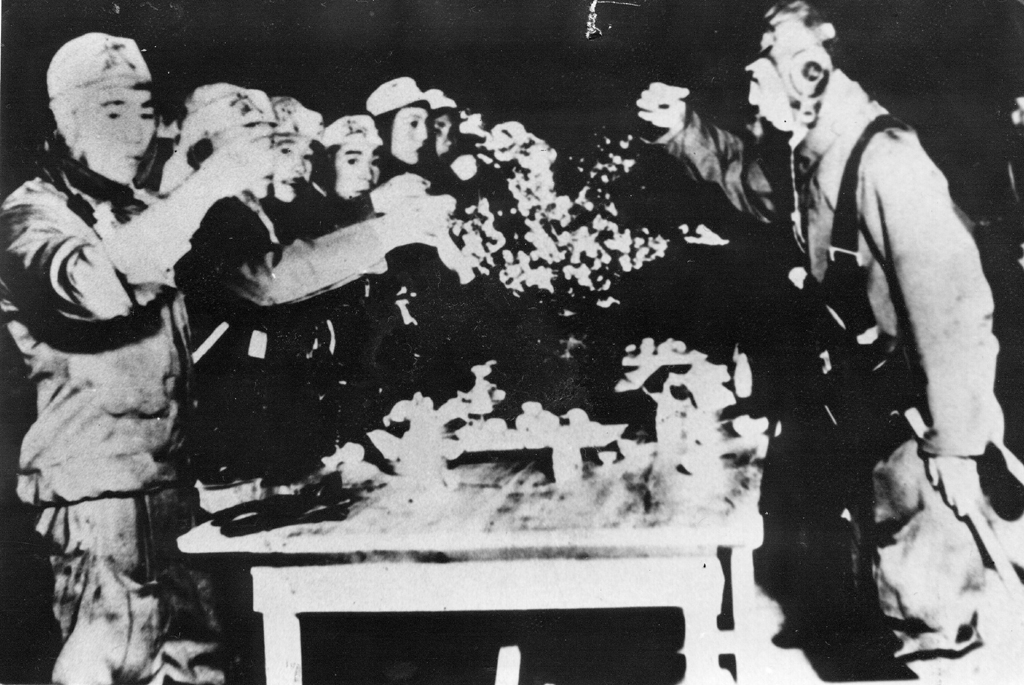
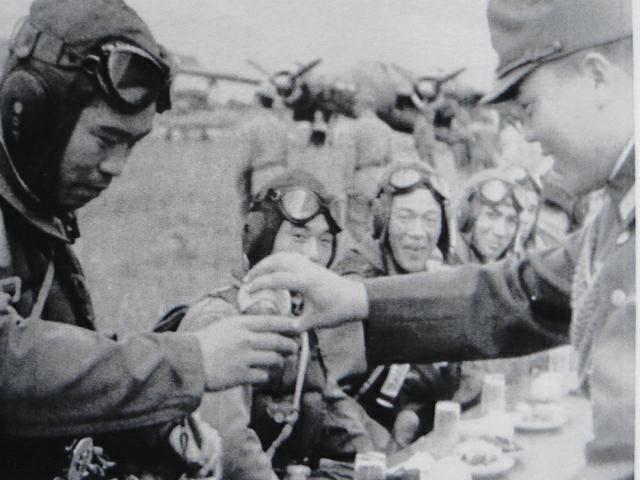
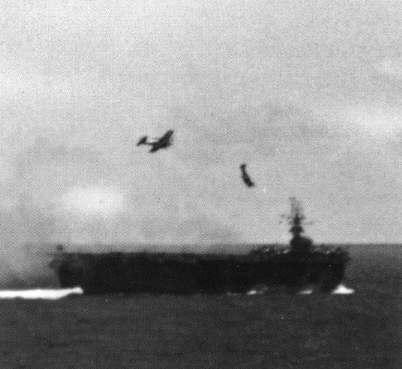
U.S. Navy
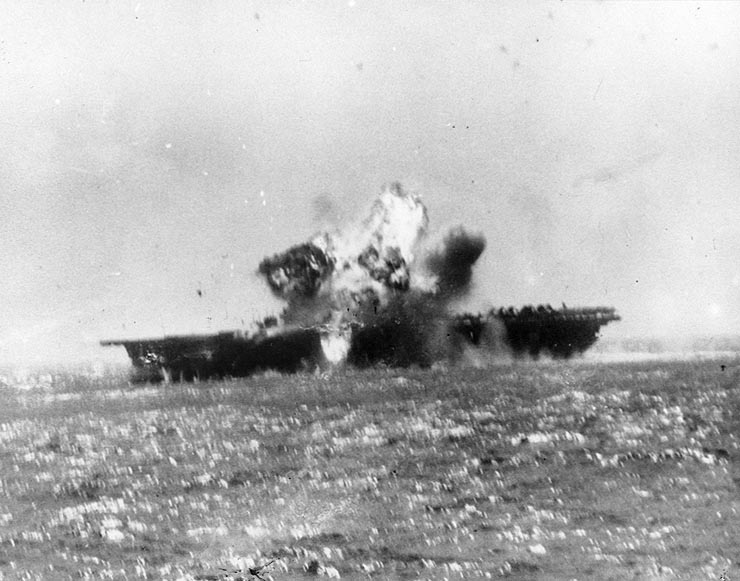
U.S. Naval Historical Center
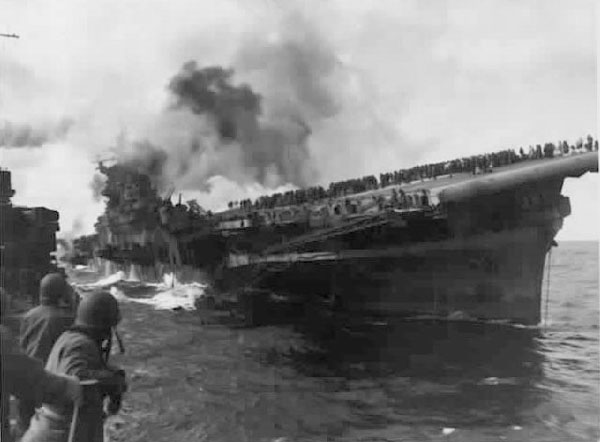
U.S. National Archives, Wash. D.C.
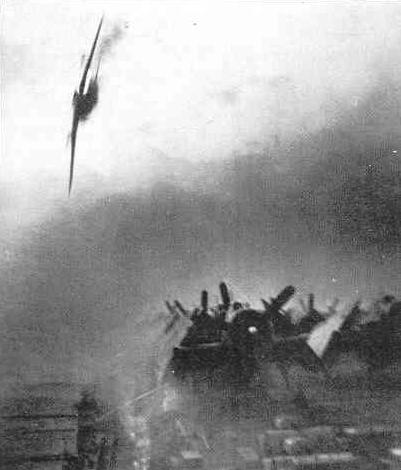
National Archives
National Archives 80-G-323712
National Archives
PhoM3c. Kenneth E. Roberts, May 11, 1945.
National Archives 80-G-328610
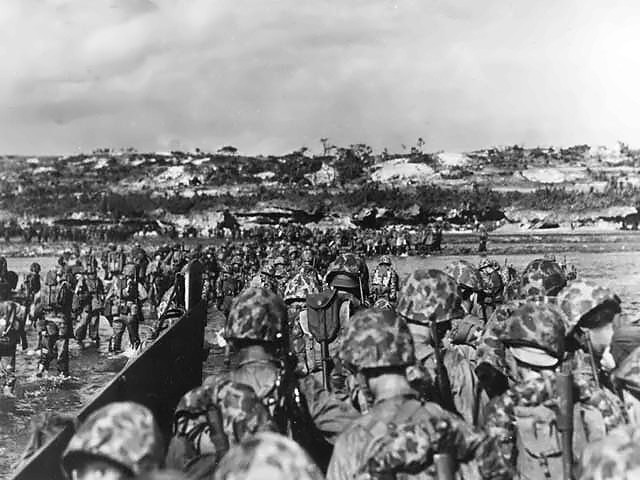
Marines of the US 10th Army
in camouflage battle dress storm out of a landing craft to
establish a beachhead, March 31, 1945
on Okinawa, largest of the Ryukyu (Loochoo)
Islands, 375 miles from Japan.
National Archives,
39573-FMC
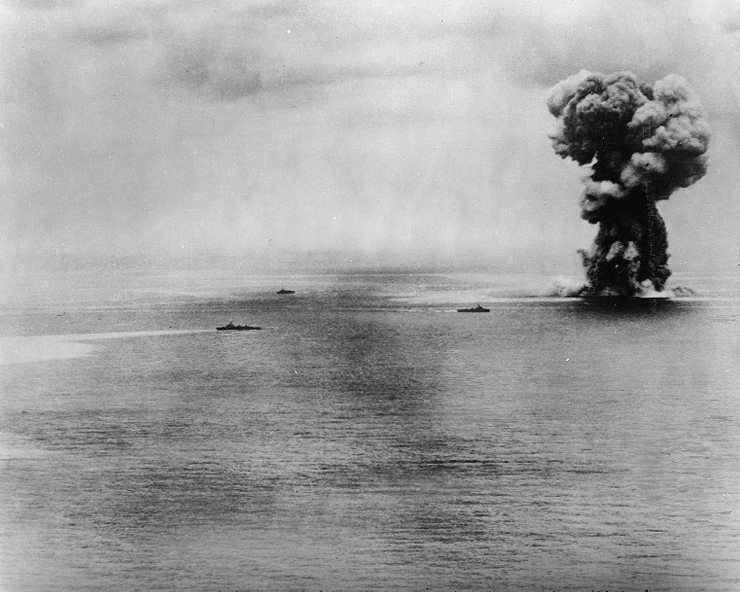
Japanese battleship Yamato
blows up after receiving massive bomb and torpedo damage from U.S. Navy carrier planes,
north of Okinawa on 7 April 1945. Three Japanese destroyers are nearby.
US Navy - National Archives
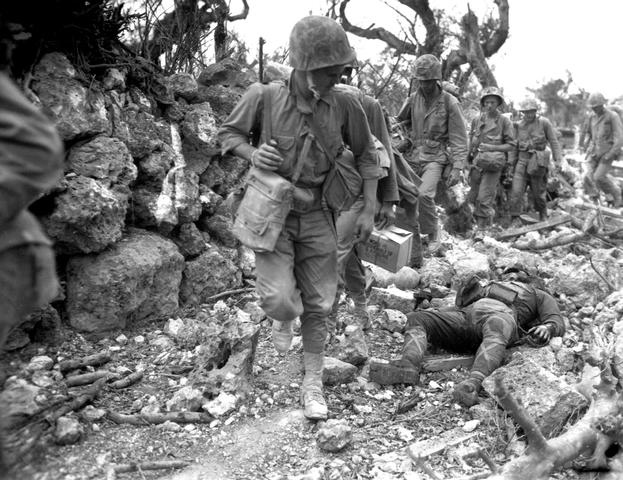
National Archives 127-N-95-119485
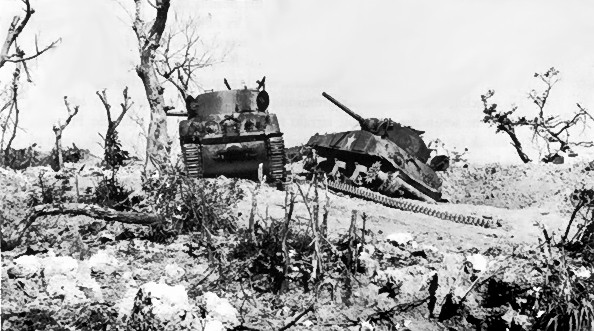
The attack on bloody ridge
of 20 April was marked by severe fighting. During the fighting on Bloody
Ridge two medium tanks were knocked out by Japanese artillery fire
from the Pinnacle.
US Army
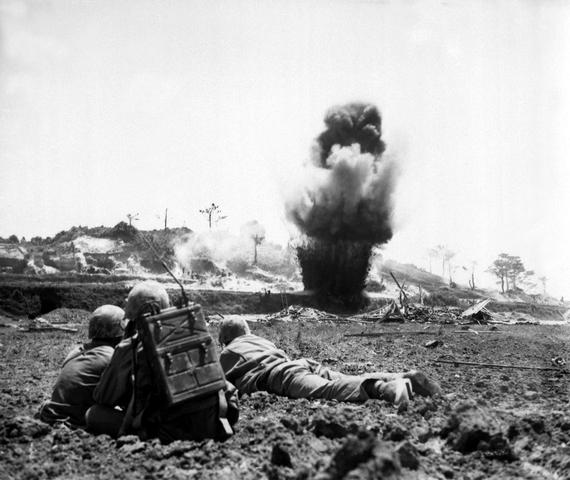
A demolition crew from the
6th Marine Division watch dynamite charges explode and destroy a Japanese cave.
Okinawa, May 1945.
National Archives,
127-N-122154
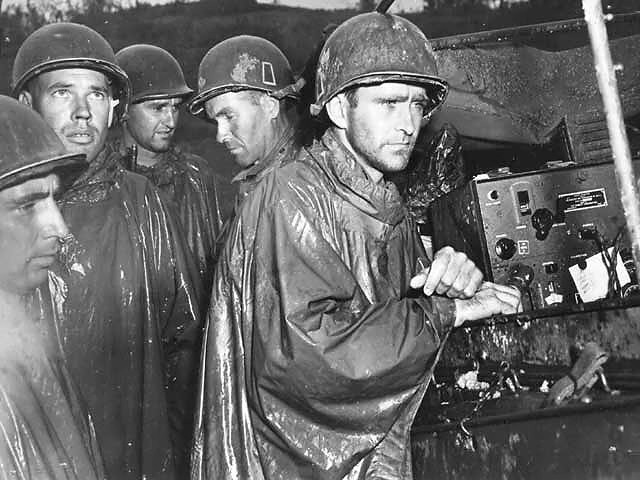
A few yards behind the front lines on Okinawa, fighting men of the US Army's 77th Infantry division listen to radio reports of Germany's surrender on May 8, 1945.
| Their battle hardened faces indicate the impassiveness with which they received the news of the victory on a far distant front. One minute after this photo was taken, they returned to their combat post. Officially however, American forces on Okinawa celebrated the end of the war in Europe by training every ship and shore battery on a Japanese target and firing one shell simultaneously and precisely at midnight. |
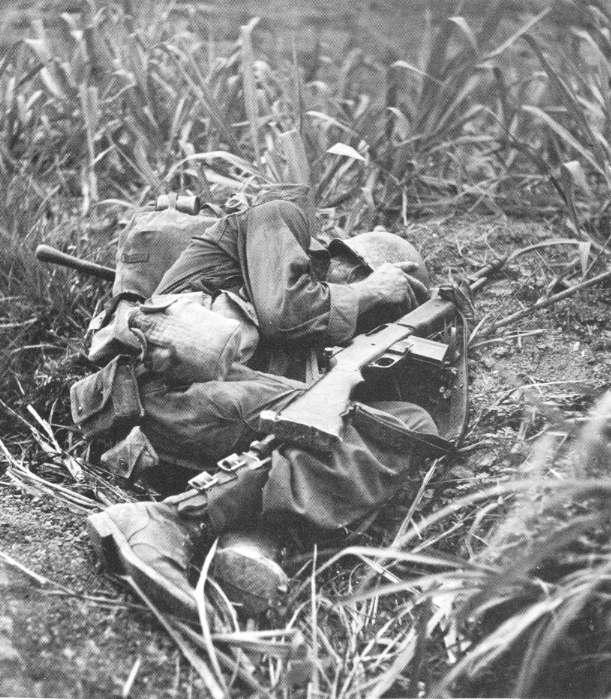
"A Marine of the 1st Marine Division
draws a bead on a Japanese sniper with his
tommy-gun as his companion ducks for cover. The
division is working to take before the town of Shuri." S.Sgt. Walter
F. Kleine, Okinawa, 1945.
National Archives
127-N-123170
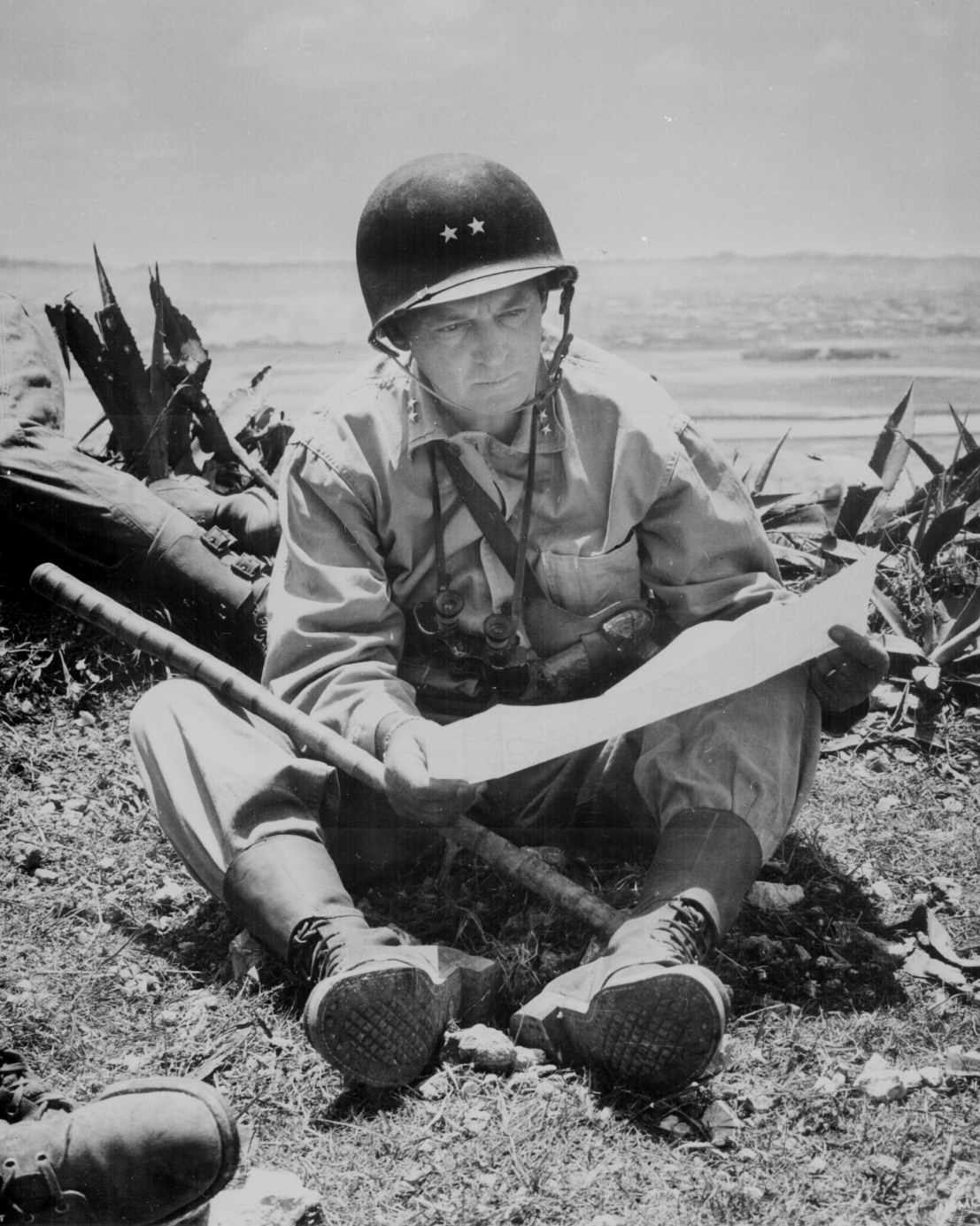
"With the captured capital of Naha as
a background, Marine Maj. Gen. Lemuel Shepherd, commanding general of the 6th Marine
Division, relaxes on an Okinawan ridge long enough to consult a map of the terrain." Pfc.
Sam Weiner, ca. June 1945.
National Archives
127-GR-95-122119
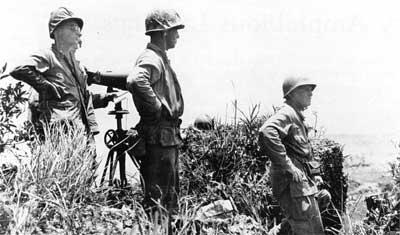
Lt. Gen Simon B.
Buckner,
Jr., USA, right, observing the 8th Marines in action on Okinawa
for the first time since
the regiment entered the lines in the drive to the south. This is the last photograph
taken of him before he was killed on 19 June
National Archives,
127-N-122154
"Corsair fighter looses its load of
rocket projectiles on a run against a Jap stronghold on
Okinawa. In the lower background is the smoke
of battle as Marine units move in to
follow up with a Sunday punch." Lt. David D.
Duncan, ca. June 1945.
National Archives
127-GR-97-126420
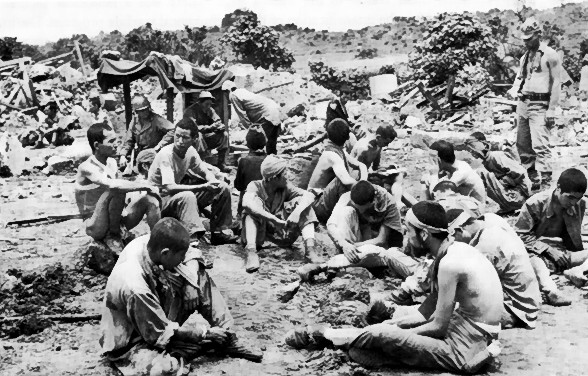
A group of Japanese prisoners
who preferred capture to suicide. They are waiting to be questioned
by American officers.
US Army
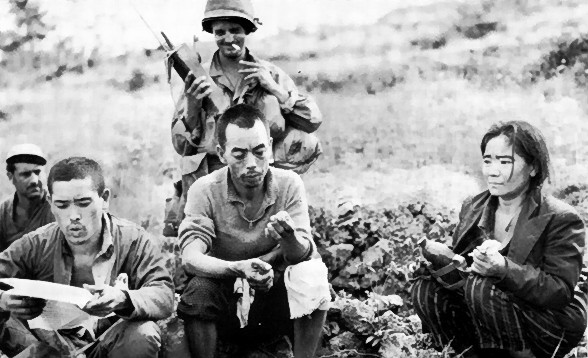
Overcoming the last resistance
on Okinawa was aided by propaganda leaflets, one of which is being read
by a prisoner awaiting transportation to the rear. Many civilians gave up at
the same time.
US Army
Library of Congress
Ishikawa Koyo
"Task Force 58 raid on Japan.
40mm guns firing aboard USS Hornet on 16 February 1945, as the carrier's planes
were raiding Tokyo." Lt. Comdr. Charles Kerlee, February 1945.
National Archives
80-G-413915
National Archives 80-G-490232

Go on to the next section: Preparing for a Post-War World

Go on to the next section: Preparing for a Post-War World



